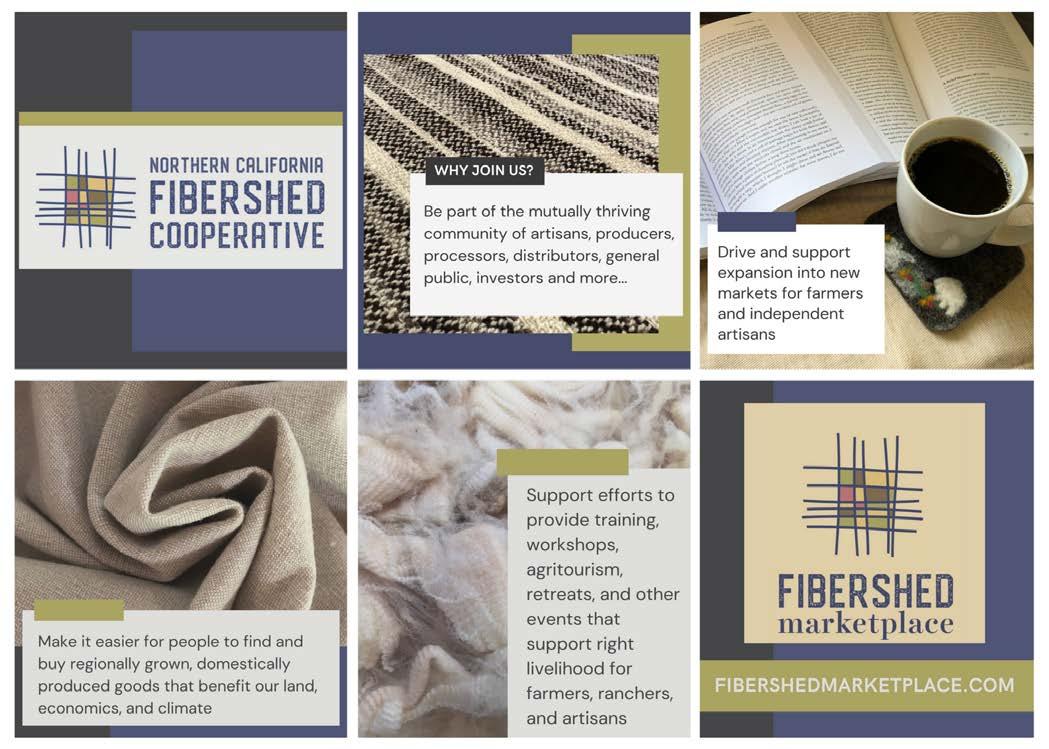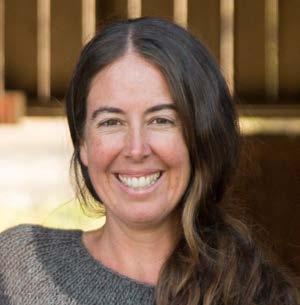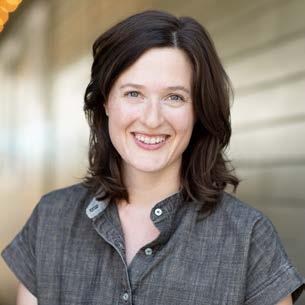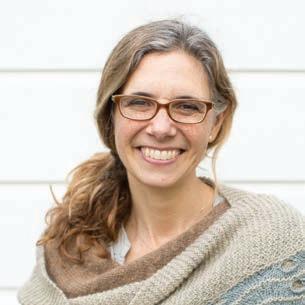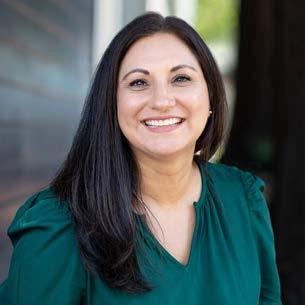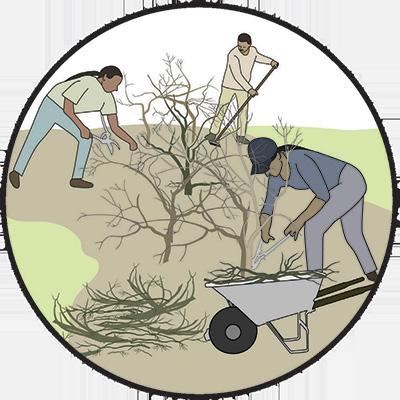

Northern California Fibershed Producer Newsletter
Tactile Reading for the Fiber & Natural Dye Community
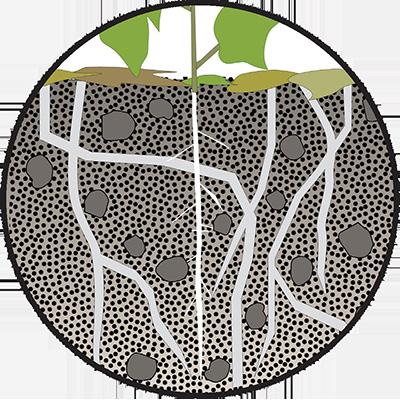
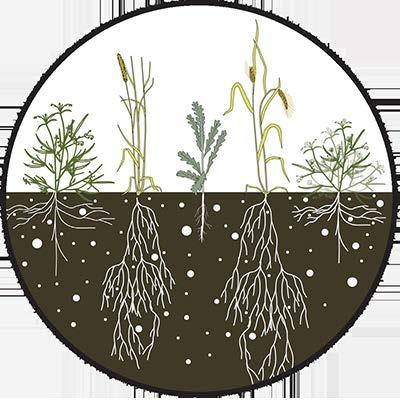
From top to bottom: Indigenous stewardship of dogbane involves modeling traditional practices like burning and brush clearing; Dogbane is harvested by indigenous California tribal members for cordage and regalia; underground soil biology is highlighted—microbes and fungal networks excite the liquid carbon pathway; sheep are grazed and move carbohydrates (fresh carbon and water) through their rumen and transform it into protein (wool); Sheep are sheared.
Learn more about these practices at fibershed.org/fiber-visions
Illustrations by Amanda Silvana Coen www.amandacoen.com
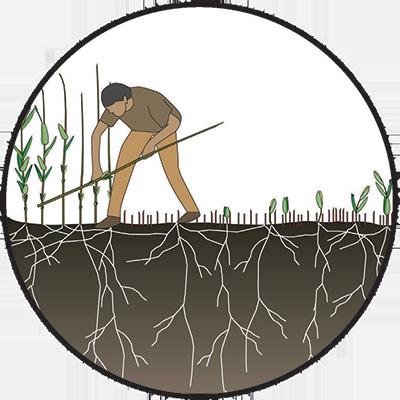
2 • Envisioning a Carbon Farming System Fibershed’s Carbon Farm Seed Fund
3 • Fibershed Learning Center Virtual Classes and Demos
• Mendocino County’s Fibershed Cohort
• California Healthy Soils Program update
• Save the Date: Fibershed Producer (Virtual) Meet-up
4 • Welcome New Producers
• Producer Voices
• Producer Classifieds
18 • Call for your Classifieds, Art, Poems, and Stories
• Fibershed Affiliate Voices
20 • Join the Northern California Fibershed Coop and Fibershed Marketplace
• Fibershed Staff
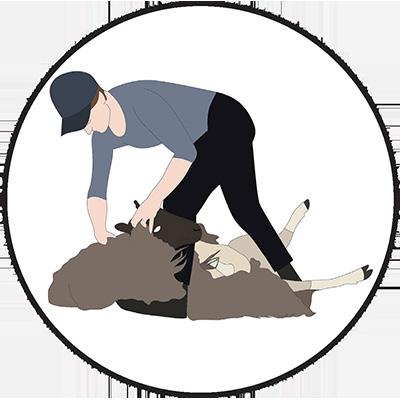
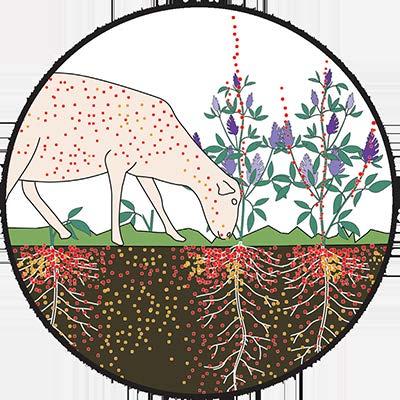
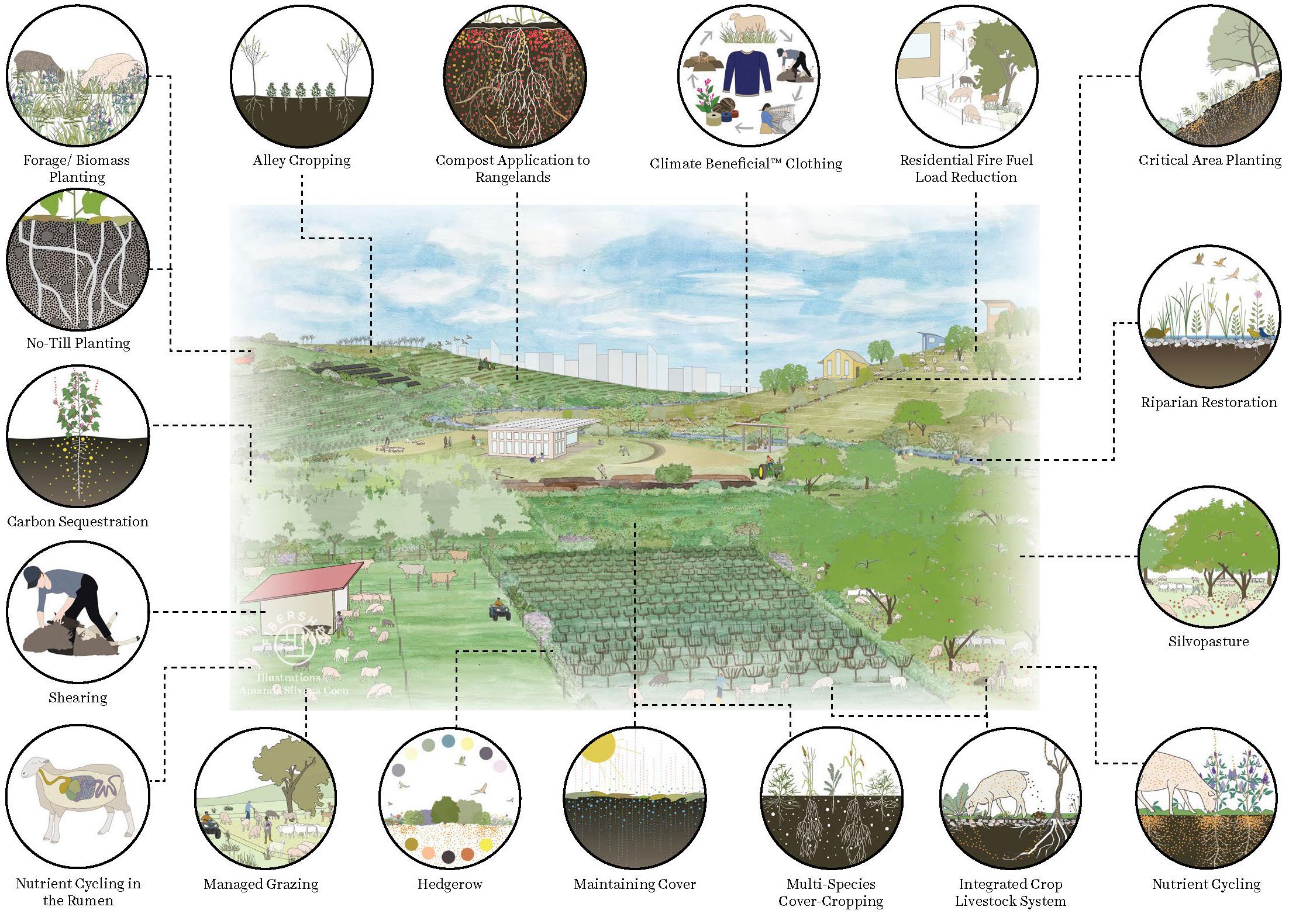
Envisioning a Carbon Farming System
ILLUSTRATIONS BY AMANDA COEN
To better communicate the principles and opportunities in carbon farming, Fibershed collaborated with a landscape architect, Amanda Coen, to illustrate a landscape-level perspective of a Northern California fiber, food, and dye farm focused on enhancing carbon drawdown. The landscape illustration depicts a number of carbon farming practices in relationship with one another. Embedded within the illustration is a series of “zooms” that present a close-up of important concepts. The landscape illustration and the zooms can be used in any combination or as stand-alone pieces. These pieces allow Fibershed to incorporate them into future resource materials, educational discussions focused on specific carbon farming practices, such as hedgerows, and inspire discussions about what might be possible when many of these practices are employed. To view all illustrations, please visit: bit.ly/ CFDrawings.
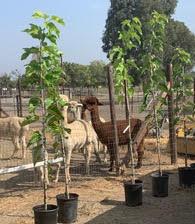
Fibershed’s Carbon Farm Seed Fund Accepting Applications in Summer 2021
Fibershed launched the Carbon Farm Seed Fund in 2020, offering small grants for carbon farming projects on farms and ranches in our Producer Program community. Twelve producers received grants in the initial round to implement carbon farming projects on their operations, with a combined total of $52,992 in granted funds to support 21 practices directly involving 242 acres. The diverse practices involved in these initial projects indicate the wide range of opportunities for carbon farming within our region: silvopasture, windbreak and shelterbelt, tree and shrub establishment, compost application to croplands, compost application to rangelands, range planting, biomass and forage planting, prescribed grazing, mulching, cover crop, and conservation cover.
The Carbon Farm Seed Fund offers small grants to producer members typically in the range of $2,000-6,000 for carbon farming projects that are ‘shovel ready.’ This means that the project design is clear; planning is done for acquiring needed materials and labor; and the project can be completed within the coming year.
Guidelines and application materials for 2021 grants from the Carbon Farm Seed Fund will be released in early summer, so stay tuned to Fibershed’s producer email updates for more information.
Left: Mulberry trees ready for silvopasture planting at Integrity Alpacas, supported by a Carbon Farm Seed Fund grant (Photo by Charlene Schmid)
Fibershed Learning Center Virtual Classes and Demos
BY DUSTIN KAHN
Due to restrictions imposed by the pandemic over the past year, like many organizations, the Fibershed Learning Center has been fulfilling its mission in part via Zoom.
Originally intending to hold in-person workshops and events in our inspiring location—on the ancestral territory of the Coast Miwok within the historic Black Mountain Ranch property in Point Reyes Station—we have instead offered webinars during the pandemic. As a result, we have been delighted to welcome students from far and wide.
In 2020, we hosted 580 students from 16 countries and territories (Brazil, Canada, Finland, India, Israel, Luxembourg, Mexico, Morocco, Norway, Portugal, Puerto Rico, Qatar, Sweden, Switzerland, United Kingdom and the United States) as participants in 9 virtual Learning Center demonstrations and classes that were each around 75 minutes in length. We began 2021 with a series of online classes that were 3 hours long and offered more detailed instruction—also well received.
If you are interested in teaching a class or giving a demonstration via the Learning Center, please contact learningcenter@fibershed.org. Proceeds from each event support the class instructor and contribute to Fibershed for educational programming. A portion of the proceeds is also shared with a local and mission-aligned non-profit organization selected by the instructor.
All past webinars are made available on Fibershed’s Vimeo On Demand channel, and profits are split with the instructor (vimeo.com/ fibershed/vod_pages). Topics so far have included natural dyes; flax growing and processing; indigo growing and vat making; sewing tips; indigo pigment extraction; knitting with local yarns; making inks, paints and pastels from indigo and other pigments; and weaving on a rigid heddle loom. A demonstation on native plant fibers is scheduled on March 13th, and natural paints on fabric is scheduled on April 3rd.
For the Learning Center schedule, visit fibershed.org/learningcenter
Mendocino County’s Fibershed Cohort
BY KATY BRANTLEY, SOILS PROGRAM MANAGER, MENDOCINO COUNTY RESOURCE CONSERVATION DISTRICT
Grazing, sheep rearing, and fiber production have a long history in Mendocino County. Today, places like Mendocino Wool and Fiber Festival, Pacific Textile Arts, Mendocino Arts Center, Mendocino Wool and Fiber, Inc., and now Fibershed are helping keep these traditions alive. Sheep are still utilized for grazing, fiber, and meat by land stewards such as Peggy Agnew of Red Creek Farm, Blaire AuClair of Radicle Herbs, Gowan Batist of Fortunate Farm, and Ruthie King of New Agrarian Collective. Hopland Research and Extension Center maintains a flock, shepherded by Alison Smith, and hosts a sheep-shearing school every year as part of its educational mission. Fibershed has brought all these fiber producers together in a Carbon Farm Cohort, in partnership with the Mendocino County Resource Conservation District (MCRCD). MCRCD is excited to help facilitate the Mendocino County Carbon Farm Cohort with Fibershed, as staff not only get to help develop carbon farm plans for each member, but they also support fiber producers with best management strategies for their land, facilitate business-oriented discussions, and make essential connections to enhance the producer network. What is starting as a smaller cohort group will hopefully grow into a strong web of enterprises, all contributing to a climate resilient Mendocino County fiber system .
Local animal husbandry and fiber production play critical roles in conserving working landscapes to enhance the health of the water and soils in Mendocino County, which are essential aspects of MCRCD’s mission. By assisting these fiber producers with developing conservation plans based on carbon beneficial practices, such as planned grazing, applying compost, installing a hedgerow or a windbreak as an example, MCRCD and Fibershed can help ranchers and farmers link their products directly to environmentally beneficial outcomes. Through this cohort and its eventual expansion, MCRCD hopes that Mendocino County will be a model for how to produce local food and fiber while also protecting our incredible natural resources.
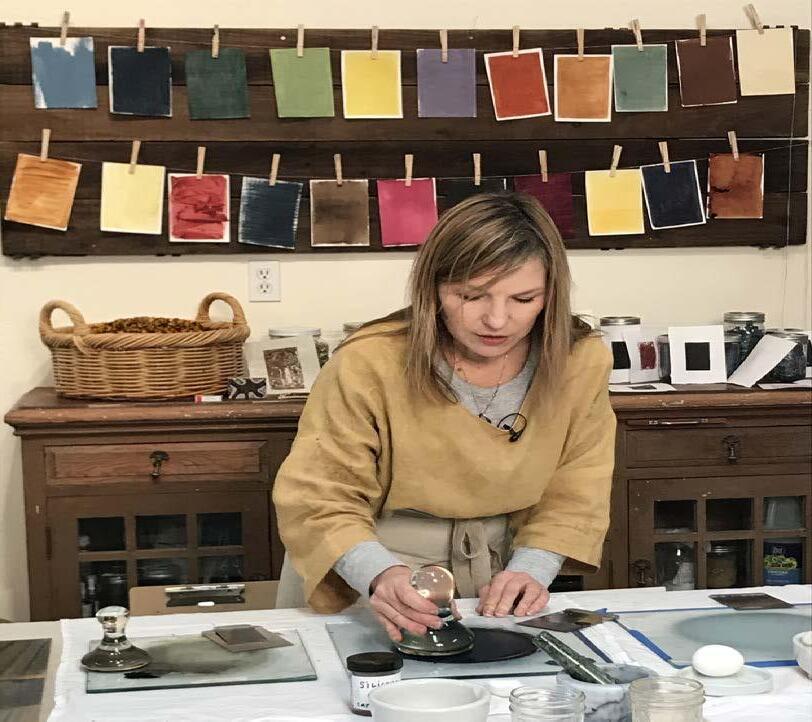
Above, artist Judi Pettite teaching an online class on natural paints. When asked about her teaching experience, Judi said, “There are so many reasons why I love teaching at the Learning Center—the idyllic setting at Black Mountain Ranch in Point Reyes, the spacious demonstration area, as well as the support from Dustin, Rebecca and all the professionals at Fibershed. Connecting to a broader audience through the online classes has been amazing and truly special; I feel fortunate to have participated in the first year of education programs at the Learning Center and can’t wait to see what’s on offer in 2021.” (Photo by Dustin Kahn)
California Healthy Soils Program update
(as of February 2021)
Despite the challenges inherent in the past year, 2020 saw record interest, applications, and funding for the Healthy Soils Program (HSP) operated by California’s Department of Food and Agriculture. These Incentives and Demonstration project grants have become a critical source of support for new farming practices across the state to sequester carbon, reduce greenhouse gas emissions and build healthy soil. However, the potential for HSP funding in 2021 is still unclear. While the Governor has proposed an “Early Action” budget allocation to allow for HSP grants’ issuance in both 2021 and 2022, funding may be postponed with the funds still to be approved for issue in early 2022. We are glad to know that funding for the Healthy Soils Program is still a priority for California policymakers, even if funding is interrupted for the current year. Fibershed will keep producers updated with information about HSP funding opportunities as the state makes these decisions in the coming months.
Save the Date: Fibershed Producer (Virtual) Meet-up
Friday, April 30, 12:30-2:30 pm
We have missed seeing all of you in person over this past year! While we look forward to being able to gather together again on the land, we will have the next Fibershed Producer Meet-up virtually on Friday, April 30. Our meet-up agenda will include live tours and conversation from our local mill operators who are growing and expanding their services to meet the needs of our growing fiber community.
We look forward to seeing you all there for a chance to connect, learn, and be inspired by the amazing ongoing work of our community!
Please stay tuned for an email with information on how to attend the Meet-up; if you do not receive the monthly Producer emails from Fibershed, please reach out to Marisol@fibershed.org
Welcome New Producers
We want to welcome and highlight producers who have joined our Northern California Producer community since the publication of the previous issue of this newsletter. As always, you can find information about local fiber, dyes, and skills within our community, alongside direct links to contact or support their enterprises, in our Producer Directory: fibershed.com/producer-directory/

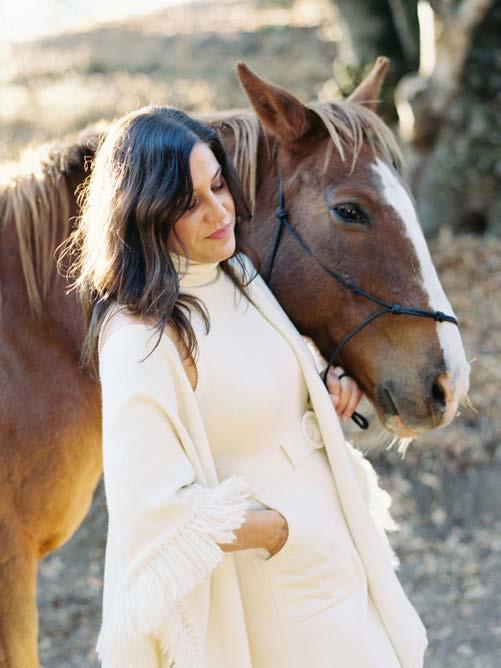
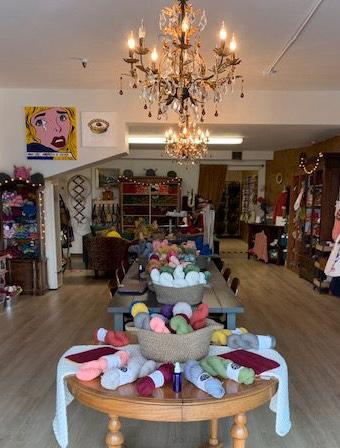

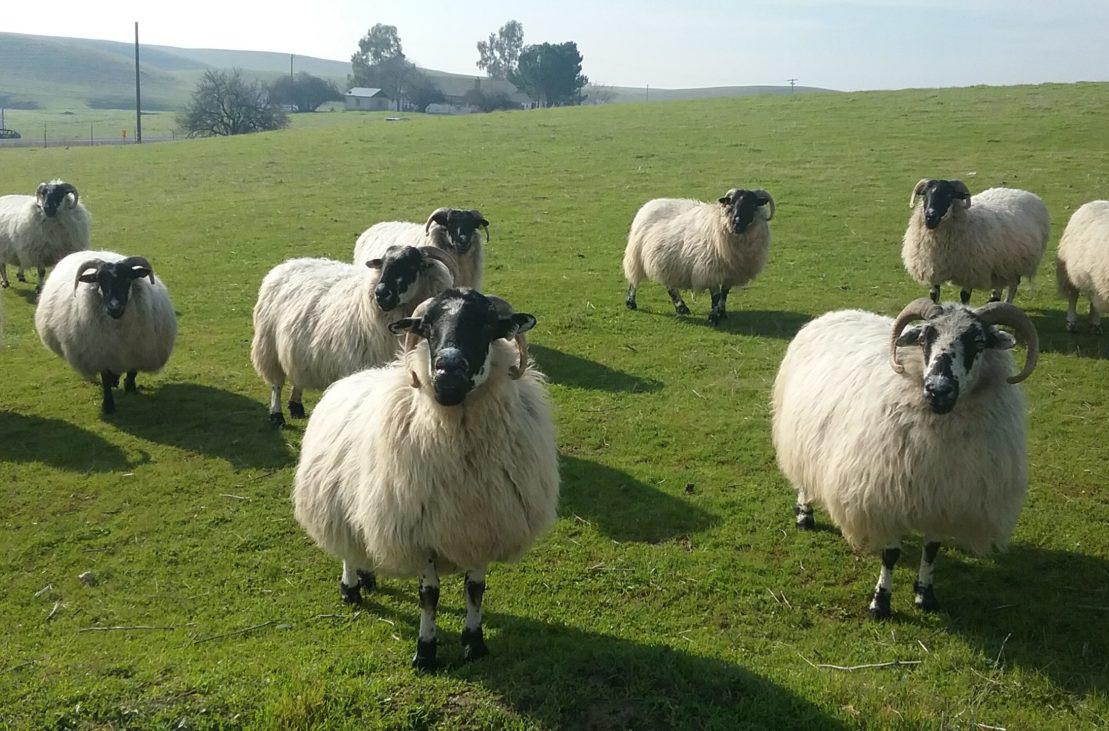
• Ziz Land – exploring across materials, Alissa Kaplan is an artist who creates knit and woven garments with handspun wool sourced from local farms, as well as baskets and handcrafted brooms
• The Royal Bee Yarn Company – in the coastal community of Pacifica, The Royal Bee Yarn Company offers a cozy shop with an in-house line designed from fleece to fiber, produced within the US, and dyed naturally
• Sonya Hammons – creating fine art, custom hand-felted and handwoven fabric yardage, garments, home goods, and acoustic insulation panels with handmade felt from local wool, salvaged boat rope, and local pigments from her artist-geographer studio in Sausalito Bottom Row, left to right:
• Stick & Ball – focusing on sustainable apparel, accessories, and home decor, Elizabeth Welborn created this equestrian-inspired lifestyle brand drawing inspiration from the rolling country hills of California down to the vast pampas in Argentina
• Three Bags Full Wool – grazing Scottish Blackface sheep along the rolling hills of Yolo County, Les Pfardresher and Three Bags Full Wool are a working Border Collie ranch with durable wool available in raw fleeces, roving, and more
Top row, left to right:
Producer Voices
Rotational Grazing Planning (RGP) Tool
BY AMY SKEZAS
My husband and I carbon farm with Ouessant-breed sheep on nine acres of dry, hilly land. Our mentor is Leslie Adkins of Heartfelt Fiber Farm.
We are building a small flock gently over time. In 2017 Leslie loaned us Freya, a ewe who gave us twin lambs. With the 2020 lambs, we now live with thirteen intelligent, charming, inquisitive little sheep.
The land here historically has been overgrazed. We are rebuilding the soil. We love our partnership with the flock, increasing carbon sequestration and moisture retention in the land. We are building wildfire resilience and watershed vitality.
From 2017 – 2020 the flock grazed on one acre. The other six acres were guest grazed by cows during the high grass season. We decided to bring those six acres under our management. So now we are putting rotational grazing into practice on seven acres. In 2021 we hope to cross-fence the back pasture and increase watering spots so that the animals can stay put each day in one paddock. My husband designed and built a prototype shelter with a special roof to help keep the animal’s cooler out in the back pasture where there are no mature shade trees. We have designed a layout for back pasture paddocks to maximize access to centralized shelter and water stations.
Some of our particular circumstances for grazing planning are:
• We are small
• We are new farmers
• We are entering our elder years
• We do not harvest meat
• We have foxtails
• Portable electronet fencing is not practical here It’s been a real challenge to figure out:
• How much grass can we expect?
• How many sheep can this land support?
• How can we manage all the different variables that go into a grazing plan?
The grazing courses I’ve attended were geared toward meat operations, usually larger operations, and emphasized the use of electronet. Some of their planning tools miss the mark for some of our particular circumstances.
To make planning easier, I built a Rotational Grazing Planning (RGP) Tool in an Excel spreadsheet. It’s helping me, and if you also are grappling with grazing planning, I hope it can help you.
If you’d like to check out my homegrown RGP Tool, it’s available to download for free at meridianfarm.org/planning-tool-for-rotationalgrazing. You can read about the information to gather to use the tool at meridianfarm.org/projects/rotational-grazing
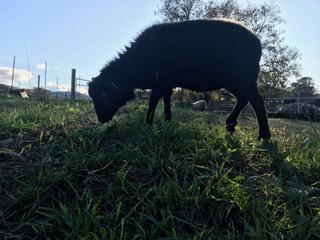
Bodega Pastures
BY HAZEL FLETT
WhenI moved to our ranch from London in 1979 at age 30, I knew I’d never be as competent as if I had been brought up on a ranch— working with other ranch families who had been running sheep longer than I was how I learned the art and science of shepherding. Also, classes at the local Junior College and educational events like Field Days by the North Bay Wool Growers Association helped.
Now I find myself mentoring some of the young people who grew up on our ranch as well as their children. When I am not available, as these days I am often taking care of my husband, they can run the sheep without me. They have skills such as felting and tanning that complement the knitting I learned in childhood and spinning skills that I developed with our own fleeces over the years.
We have three generations of fiber farmers on our ranch, the children spanning from 7 to 18 years old. The younger children, Aspen (8), Emma(7), and Luke(9), love to herd sheep and bottle feed lambs. Aspen can hop on her mountain bike and ride over the bumpy fields to get ahead of the herd before they take a wrong turn. Luke especially likes to help remove old permanent fencing that my generation built and is ready to be replaced. Often the younger children have an even more acute eye for the lambs and can spot one who needs extra care during those crucial early days after birth.
The older kids, Demetri (18), Moses (16), Trinity (20), and Orion (18), can herd sheep alone, stack hay bales in the barn, build fences, as well as take on adult roles during hoofing and shearing days. As young children, Trinity and Orion’s family would often take in the “bummer” or orphaned lambs in the winter and bottle feed them at their house. Upon reflection, their mother says, “I remember the crazy schedule with lambs, work, school, and the messy house and how it never seemed to stop. But now, Trinity and Orion say that working with the sheep is the greatest gift from growing up here on the ranch.”
We older generations often say those kids will soon be managing the flock on their own. It is really wonderful to see how the sheep have threaded our families, generations together, connecting us to the land and our children to the realness of life.
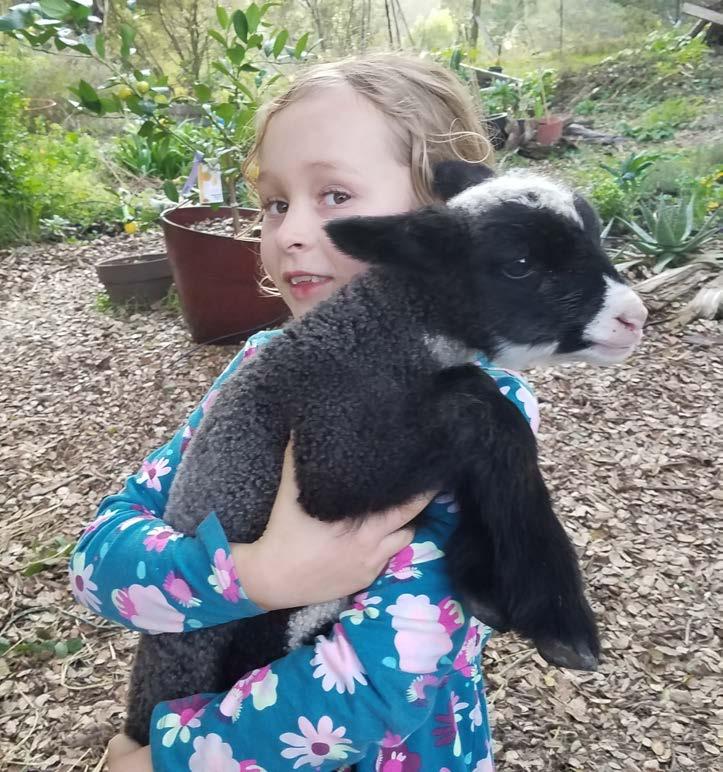
Zadie grazing in Tiny Shed Paddock at Meridian Farm (Photo by Amy Skezas)
Photo courtesy of Bodega Pastures
How to Prepare for Sheep Shearing Day
BY STEPHANY WILKES
Six key things will keep your sheep shearer showing up every year. The short list to memorize or paint on the barn wall is: dry, empty, penned, plywood, power, and masks.
1) Sheep must be dry. Wet wool tends to pill excessively, leaving lots of “second cuts” because the wool doesn’t cut cleanly. Shearers cannot shear wet sheep due to friction, “shearer’s boils,” and unsafe conditions: oil (lanolin) and water combine to make the shearing plywood slippery as an ice rink. Shearers use electrical appliances that should not mix with water. Most shearers have had at least one close call with ungrounded power on a rainy day.
If sheep go into the barn wet, they stay wet. They need to go into the barn dry. As shearer Emily Chamelin says, “If the road is dry, the sheep are dry. If there are enough sun and wind to dry out the pavement and the sheep are out in the field, they should be dry by about the same time.” Sheep and goats cannot be counted on to go into the barn when it is raining the day/night before: they will stand outside and get wet.
Simple shelter structures can be very effective, like three sides made of recycled pallets and a tarp stretched over the top, with a fence on the open side. A garage or shed will also do in a pinch.
2) Sheep must be penned. Tightly. Shoulder to shoulder. They should not have any room to run. The shearer should be able to reach in and grab a sheep from a level place beside the shearing floor. It is also more humane to flip a sheep in place rather than drag it 8-10 feet or more.
Pen sheep the night before shearing. Once a shearer pulls onto the property, forget it: sheep are smart prey animals, and they know something is up.
A shearer needs all of their energy for actual shearing; there is none to spare for chasing and catching sheep. Over the years, I have done the exact same job (same flock size, location, breeds, etc.). One year the sheep were tightly penned, and the next year they were not. Having to chase and catch sheep made for twice as long a day, measured in working hours. When sheep are not tightly penned, a shearer is being asked to do twice as much work for the same amount of pay, both exhausting and risky.
3) Sheep must be empty. Sheep must be kept off all food and water for a solid 10-12 hours prior to shearing. Grass is food. Pasture is food. Feeding grain to get them to come in is food. Anything and everything they eat counts as food.
An empty sheep is a comfortable sheep. A sheep’s rumen system can weigh as much as six gallons of liquid when full. Imagine setting six gallons of water on your stomach and laying down, with the weight pressing up against your lungs and diaphragm, and that’s a rough idea of what is happening to a full sheep during shearing. Of course, they fight to get away for all they’re worth: they’re suffering. Animals can die if they are overfull and have other conditions present.
Because this is so important, many shearers add additional fees for full sheep and/or reschedule the job and collect a ranch call for arriving to full sheep. Shearers really do want what is best for the animals and to minimize their stress so we can shear as quickly, cleanly, and calmly as possible. Sheep can be released to food and water immediately after shearing.
4) Power. While there are some battery-powered shearing handpieces on the market now, most shearers still require access to power in order to turn their equipment on. An outlet should be grounded and not sitting in a puddle. Given the wildfires in our region, the winter and spring shearing season is a great time to check out the power safety in all structures that may have it.
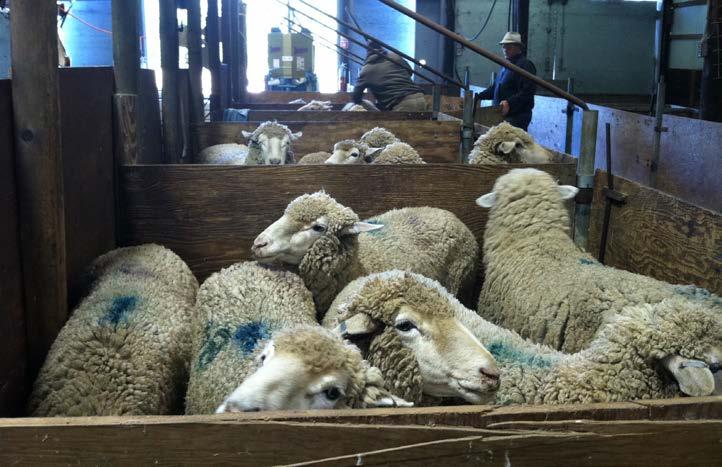

5) Plywood. Shearers love a clean, level floor. Viruses and bacteria can be transmitted from animal to animal . A shearer may make multiple stops a day when visiting small flocks during the spring rush. We do our best to disinfect between stops, but it is impossible to disinfect the plywood we shear on perfectly. Having your own plywood sheet available helps with biosecurity. Pressed plywood is best, as it is rough and provides a bit of grip for our feet. Truck bed liners and old (but dry) carpet will also do.
6) Mask up. Shearers cannot wear masks and shear safely and well. Masks fog our glasses, get kicked around by sheep and obscure our vision of both the handpiece and sheep’s body. Because shearers cannot wear them, you should. Maintain a distance of at least 10 feet even with a mask on, given the new, more highly transmissible COVID strains.
Do not hesitate to ask your shearer for help with any or all of the above. Many of us are happy to build or optimize a shearing set up at a very reasonable hourly wage to make for better, easier shearing now and in the future. It is not at all unusual for a small-flock shearer to drill in 2x4s from which to hang equipment, build catch pens or rain shelters, and otherwise optimize for a shearing day that is -- sing it with me, now -dry, empty, penned, plywood, power, and masks
Top 10 Ways to Support Grazing for Fire Management
BY MARIE HOFF
If you live or work in an area prone to wildfire, you are a stakeholder, and you have a voice!
1 Consider your own surroundings and neighbors: Learn about the area you live in, how it was managed historically, and how it is managed now.
2 Hire a grazer! If you live in a WUI (wildlands-urban interface) area, talk to your neighbors about getting together and hiring a contract grazing service. If you live in a rural area, either hire a grazer or talk to your neighbors about hiring one. If you live in a suburban or urban area, talk to your local government/land trusts about hiring a grazer to manage public lands. Check out Match.Graze to find a grazer or to have your grazing services listed. matchgraze.com
3. Reach out and get involved in a Fire Safe Council near you: cafiresafecouncil.org
4. Learn about your local Natural Resources Conservation Service (NRCS) and/or Resource Conservation District (RCD): Attend meetings, ask if they recommend grazing services for fuel load management, and if you are a landowner, ask for a fire management plan or survey of your property. nrcs.usda.gov and carcd.org
5. Get to know your County Board of Supervisors: Attend meetings, send them comments or a letter (address to the Clerk of the Board) encouraging hiring a grazing service for fuel load management on county-managed lands.
6. Get to know your City Council: Attend meetings, send them comments or a letter encouraging hiring a grazing service for fuel load management on city-managed lands.
7 Shop for California-raised food & fiber (yarn/wool apparel and home goods, lamb, wine from vineyards that integrate sheep, fruits/ vegetables/grains from farms that integrate sheep). Look for local CSAs and meatshares!
Tight penning helps a shearing day go smoothly (Photo courtesy of Stephany Wilkes)
The author appreciating a clean plywood floor and easy power source (Photo courtesy of Stephany Wilkes)
8 Follow grazing operators on social media, like and share their stories!
9 Join California Woolgrowers Association (CWGA) if you graze sheep and/or goats. If you contract graze, get listed on their online directory. And/or refer your neighbors/local land management organizations/ local government/local CalFire to the CWGA directory. californiawoolgrowers.org/targeted-grazing/directory
10 Be persistent. Keep reaching out, send follow-up correspondence, keep thinking creatively, keep looking for new ways you hadn’t thought of before to encourage the use of grazing for fuel load reduction.
Things I’ve Learned About Sheep
BY MELISSA TREGILGAS
Ihave learned that sheep are like water. They are drawn to the smallest gap, gate, or hole in the fence and flow through it steadily. When one sheep finds the hole, the rest follow as if molecularly bonded. Even the typically recalcitrant lollygaggers make a concerted effort to slip through with the mass of the flock like the last drips of a spill. When they hit the new grass, they spread out in the pattern of oil soaking into a tablecloth. Just like water, which is impossible to return to the bucket via the crack it leaked out of, you will need to find a large gate to get them back through. They will not return through the little gap they poured out of, except by a sort of black magic skilled shepherds must employ in emergencies.
Sheep are also like fire. They love to move uphill. It is almost impossible to push them back down a slope they have walked up. When they are excited for fresh and tender pasture, they will leap through the gate like a licking flame. The younger sheep will shoot out ahead, and then little bunches of ewes collect around them, mowing through the forage and slowly spreading out until they are like a line of grassfire, marching to the rhythm of their grinding teeth. The land can regrow to be sweet and blossomy if given rest after sheep or fire move through.
Sheep are like humans. They require each other’s presence in the flesh to maintain health and soundness of mind. Even that old bitch of an ewe who butts interlopers and seems self-satisfied at her feed would be distressed without the flock. Naturally timid, curiosity will move sheep to explore all new things if given time. Sheep prefer their own breed and their own flock-smell. But time and proximity will overcome all disdain, for a sheep is a sheep.
Sheep are unlike humans. The ewe is a career woman, and raising lambs is her career. The pride of her adulthood is a pair of fat twins. She keeps company with her own daughters in the flock for years to come and is content to never explore beyond her home range. A ram is never tender like a man. The bluntness of his shattering blows as he tests the thickness of his skull against things is not a special hate for anyone. It is the language of his kind, just as the low knicker of the ewe is for the lamb.
Sheep are grim and holy creatures, ridiculous with their full fleece and stoic faces. People who categorize sheep as stupid are typically too stupid to know anything about them. Sheep are very reasonable and never lie. In the distance, they appear as scattered stones against the green of the spring hills. They weigh like stones in the mind of their shepherd. While you are lacing up your boots to walk out to the flock, you are already thinking of them.
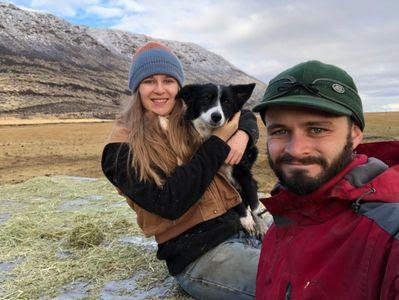
Next Generation Farmer
BY LANI ESTILL
ALE Sheep Company was started by Anna (Estill) Odendaal in high school as an FFA Supervised Agricultural Experience. Being raised on a large scale sheep and cattle operation, she had a love for animals and the mind of a business owner. In 2012, when she had the opportunity to purchase a small flock of Suffolk ewes, the choice was easy. She took all the money she had saved from her 4-H lambs over the years, sold the 10 head of goats she currently had, and became the proud owner of 40 head of Suffolk ewes! With her family’s help—and now her husband Riaan (pictured above)—Anna has run the same flock ever since!
The ALE flock is made up of Suffolk sheep. This breed of sheep originated in Britain during the 18th century. Suffolk sheep have black faces with white bodies, are naturally polled (without horns), and are raised primarily for their meat. Their meat is lean with excellent taste, texture, and flavor.
She has sold lambs to kids for their 4-H Club projects and rams to the Bare Ranch. She also sells meat through the Modoc County Food Hub, the Great Basin Foo 0d Cooperative, and now on her new website Alesheepcompany.com.
The sheep are the Bare Ranch weed burners and are moved from pasture to pasture throughout the year. Right now, they are at her brother Cole’s house in Winnemucca for lambing. Anna commutes on weekends to do her part and not lean too hard on her brother. Anna is an Ag Teacher at Fernley High School in Nevada, where she teaches the next generation about agriculture. She and her husband, Riaan Odendaal, are working hard to buy a property where they can live and run their sheep.
Ever since she was little, Anna has loved her dogs and her lambs. Watching her continue with her sheep into adulthood is a real pleasure!

Anna, Riaan, and Diamond feeding the sheep at the Bare Ranch
Sheep grazing at Freehand Farm (Photo courtesy of Melissa Tregilgas)
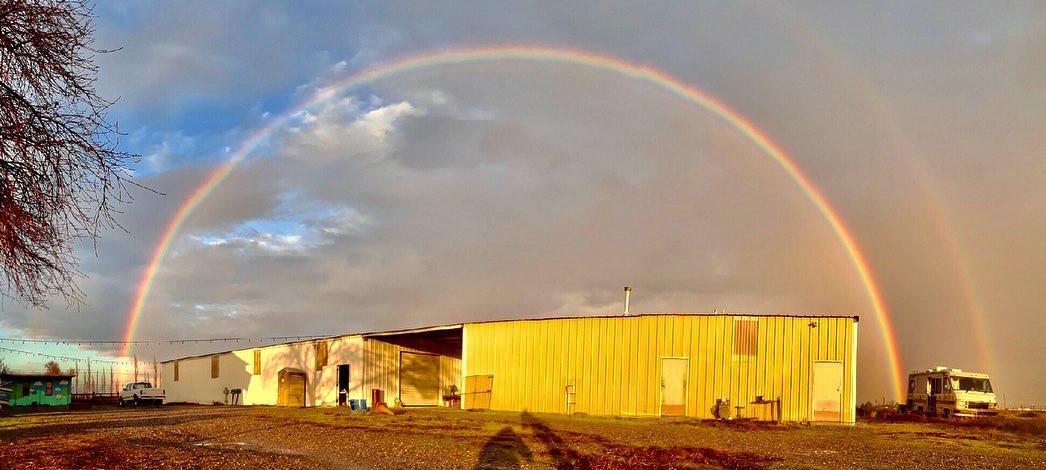
Valley Oak Wool Mill Update
BY MARCAIL McWILLIAMS
Thank you to all my wonderful customers who showed generosity and commitment to their orders. I’m so thankful to everyone who supported the mill. Valley Oak Wool Mill (VOWM) made it through 2020 and had the best year ever!
Last year I attended a few virtual shows, some went better than others, but it was a good learning process and a time to develop online sales. I participated in a group called WAFA, Wool and Fiber Arts, live sale through Facebook in the summer, Lambtown in October, and the Fibershed Wool Symposium in November. I will be participating again with WAFA this month (February), and I’m also participating in a virtual field trip for elementary schools in Yolo County.
The Yolo Arts Council has paid me to work with their program to develop a video tour of the mill and participate in a live Q&A session with the students. They also purchased wool supplies for the students to make a felted hat! Tours for children have not been something I was very open to in the past, but this was a good opportunity since it’s virtual, and
Flax Webinar
BY SANDY FISHER
On January 28, Chico Flax hosted a webinar that brought small scale flax growers and processers together from around the world to share their work: “Building a United Nations of flax: perspectives on creating small scale flax growing and processing industries.”
I was very excited to be the host, along with a panel of experts from the United States, Canada, and Europe who have a vision to create a regional flax-to-linen industry. The panel was composed of artisans, educators, and farmers undertaking flax production in collaboration with local universities, yarn manufacturers, and designers. The webinar addressed: overcoming growing/production challenges, changing from hand processing to mechanical small scale mini-mills to provide locally sourced fibers, seed production to meet the demands of a growing flax industry, and innovative partnerships working toward reestablishing a regionally based linen industry.
The presenters were as follows:
• Sarah Pottle and Jess Boeke, Rust Belt Fibershed and Cleveland Flax Project
• Jeffrey Silberman, Fashion Institute of Technology (retired), Maple Shade Farm and New England Flax and Linen Study Group
• Michelle Parrish, Western Massachusetts Fibershed and the New England Flax and Linen Study Group
• Rosie Bristow, Essex, England.
• Durl Van Alstyne, Chico Flax LLC, California
• Patricia Bishop, Tap Root Fibre Lab, Nova Scotia, Canada
• Pascale Gatzen, The Linen Project, Netherlands
• Shannon Welsh and Angela Wartes-Kahl, Fibrevolution LLC and Pacific Northwest Fibershed, Oregon
the hands-on art project should hopefully connect some dots from sheep to the finished product.
In the last quarter of the year, I took an intensive business class through the SBDC that gave me good connections and knowledge to make the mill even better. I’m encouraged by the advisors I now have on my side to help me through the issues that the business faces.
In December, I processed mostly batting, which turned out really well. I intend to keep batting production as a cool weather activity since it’s more of a struggle to produce yarn in the cold. My employee and I are developing our method of changing the machine to batting so that it won’t be as much work to do the switch. I’m still so thankful for her that I’m not doing all the mill work alone!
I think a lot of amazing and healthy seeds have been planted last year, and I’m excited to see how things grow and develop. It’s hard to keep up with things at times, but people keep telling me it’s amazing how much I have done and am doing. It’s rough, but one step in front of the other really does eventually get you somewhere. Keeping a healthy perspective is key, and having a trusted community to help you keep perspective is even better because we all need reminding from time to time.
I am delighted to hear back from all of the presenters that it was a very informative and successful interaction. Some of the comments were that we are on the right track and that small scale flax production is the best way to introduce linen into our communities as a variable fiber industry. We also realized that we were all pioneers who are not alone in this enormous undertaking we all chose!
Chico Flax has started a few collaborations out of this event. We will be working with Jeff Silberman of the Fashion Institute of Technology of New York to process his 2021 crop using our mechanized brake. This collaboration will allow us to work with CSU, Chico, Engineering professor Dennis O’Connor to perfect our equipment.
We are purchasing some seeds from Oregon’s Fibrevolution. These seeds have been bred for drier climates, very curious to test them out for their quality. They will grow in our community outreach program: “What it takes to Grow a Shirt” at a new location in Chico.
We are continuing our exploration in Cottolin blend using Sally Fox’s cotton, creating more weights of yarn for knitting and weaving this coming year.
This webinar was recorded. It is now available on our website (chicoflax.com) under a new heading called Flax Resources. Besides the webinar, you can also find contact information for each presenter and our new Flax Datasheet of growing flax.

Community Grazing Cooperatives
BY SARAH KEISER
One of the most pressing issues in our culture is the lack of connection to the land and our community. Community grazing cooperatives naturally address these issues in a collaborative way, building morale and harmony in rural residential neighborhoods and between diverse grazing and agriculture methods.
What makes community grazing projects, so ideal at resolving these issues is the flexibility of the model. Most current community grazing projects began with a neighbor with livestock creating a relationship with neighbors who have unused pastures that have become a burden and moving their livestock into these unused pastures. However, there are many other possible methodologies. A group of neighbors in West Petaluma interested in developing their own grazing cooperative were clear and 100% in agreement that they did not want to manage livestock year-round. To meet their fire fuel removal goal without year-round animal care, we discussed purchasing lambs or culled animals from local ranches to populate their grazing program. These cooperatives will then utilize prescribed grazing to move the livestock around the neighborhood until they have successfully eliminated all of their fire load. When the animals have completed their work and the season has caused the grass to stop growing, they will harvest the lambs to provide food for the neighbors participating in the grazing cooperative and donate one lamb to a local food bank. This method supports local sheep farms, provides fire mitigation, carbon sequestration, and nourishment, as well as endorsing a culture of giving.
In 2021, I plan to expand the neighborhood grazing cooperative model to underserved communities in extremely high fire risk zones within Sonoma County, with funding support from Fibershed, Globetrotters, and Sonoma SASS (sonomasass.org/land-stewardship). These areas include but are not limited to Sonoma Mountain, West County forested areas, and areas at the base of the hills where wildfires do the most damage. The services we provide include: training in land stewardship, on-call services to support people with the care of their livestock (vetting, shearing, hoof trimming, worming, etc.) to increase community confidence in animal husbandry acumen.

Producer Perspectives on Silvopasture
Silvopasture, a carbon farming practice that integrates trees, forage, and grazing animal management, is found on a growing number of Northern California Fibershed farms and ranches and is often included in Carbon Farm Plans throughout our region. Silvopastures can be established either by integrating grazing into a woodland or orchard, or by planting trees into a pasture. Fibershed’s Lynette Niebrugge reached out to four producers who are using silvopasture to learn about their experiences: Jill Hackett of Ferndale Farms in Humboldt County; Molly Taylor of PT Ranch (along with Eliza Greenman as project designer) in Amador County; Loren Poncia of Stemple Creek Ranch in Marin County, and Rhoby Cook of Rhoby’s Ranch in Humboldt County.
What is the type of silvopasture you established on your land?
Ferndale Farms: Our silvopasture is a slopey to steep 13 acres with approximately 7 acres of 2nd growth and two old-growth coastal redwoods, and six acres of mostly grassland.
PT Ranch (Eliza): This silvopasture design is my riff on the Spanish Dehesa model, the oldest and most sustainable silvopasture systems in the world. In the Dehesa, acorns from oak trees and leguminous ground cover provide much of the sustenance for their grazing pigs. At PT Ranch, I designed for oak trees to eventually dominate the system, only they are being nurtured by fodder banks of trees that provide protein
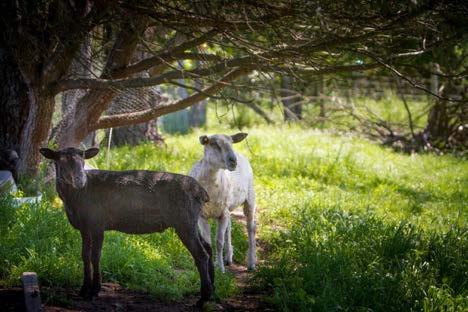
This project has always been flexible to accommodate the varying needs and skill levels of the individuals we serve. We continue to develop more flexibility and creative solutions within each grazing cooperative we facilitate. In the process of developing these Coops, we have witnessed the creation of deep-rooted relationships to the land, the animals, and neighbor to neighbor bonds that had not existed prior to the grazing cooperative. We have also witnessed a deep resolution to continue and improve the ecology—specifically, we have seen an interest in supporting the return of less flammable native perennial bunch grasses, a commitment to enhance habitat—badgers were seen for the first time in one of the collectives.
It is essential to our collective climate resilience that these grazing cooperatives populate our rural communities; decentralized growth depends upon providing sound infrastructure technical assistance and a clearly defined model for sharing responsibilities between neighbors in an easily replicated manner.
and minerals needed by livestock to offset the tannins in the acorns for better nutritional absorption. I also aimed for more diversity at PT Ranch, with a combination of nitrogen-fixing natives and pollinators to help build soil and provide sustenance to important pollinators. In a couple of years, the livestock will be able to eat from the fodder banks and benefit from their shade. In 20 years, oaks will start to dominate the canopy, and acorns will rain down. The project consisted of planting 6,000 trees, including drought-tolerant trees and shrubs, mulberries, black walnuts, olives, willows, and fruit trees of pomegranates, figs, and elderberries. [We are] layering edible crops and natural dye sources into the landscape, too.
Stemple Creek Ranch (Lynette): Stemple Creek Ranch has been diversifying their operation by incorporating grazing into the old Eucalyptus grove as well as planting trees into the pasture systems. Loren has been establishing forage, which includes a seed mix to diversify the forage in the Eucalyptus groves, which are primarily grazed by the free-range Berkshire cross pigs. Loren has also planted both redwoods and pine seedlings into his pasture systems to establish a silvopasture. At this time, livestock is excluded with the use of temporary fencing to provide protection for the seedlings. Once the trees grow beyond a browse line, these areas will be incorporated back into the pasture rotation.
How are you managing the land differently and how are you integrating livestock into this system?
Ferndale Farms: With desired species, tree pruning and thinning are management inputs instead of tree removal from non-silvopastures. Since our trees are mostly well established, we don’t have to worry much about our livestock damaging them and thus are rotated through silvopastures with the same metrics as other pastures.
PT Ranch (Eliza): The silvopasture systems at PT Ranch are designed for feeding and rotational grazing livestock in order to benefit the soils, trees, and livestock. Electric fencing will be used to fence-out the established trees. The goal is to move livestock often and offset their feed costs through cutting leaf fodder from the trees along the way. I have estimated paddock sizes for PT Ranch, given their desired stocking rate. This will need fine-tuning but will provide a head start in adapting their stocking needs to the silvopasture plantings.
Stemple Creek Ranch: We pulse graze around the ranch, and seasonally we aggressively graze smaller areas for a short duration of time. The areas where we have established seedlings over the last two years are currently excluded from our rotation but will be incorporated once the trees have had time to establish and grow.
Some of the animals working with the Penngrove Grazing Project, a community grazing cooperative (Photo by Marlene Ortiz Smith)
PT Ranch (Photo by Paige Green)

What motivated you to implement Silvopasture(s) on your landscape?
Ferndale Farms: Having silvopastures in many areas of our landscape makes a good deal of sense due to our steep terrain and the native presence of coast redwood and because silvopastures provide shade and shelter to livestock, carbon sequestration benefits, and a diversification of income streams.
PT Ranch (Molly): So many reasons! Initially, we were really impressed by the carbon sequestration benefits. Having a Carbon Farm Plan set us up for implementation nicely because we had already considered the practice and its benefits. When we were approached by the B Corporation PUR Projet with funding, we felt comfortable accepting and working with our designer, Eliza Greenman, on the more specific questions of species and placement.
Stemple Creek: To create more diversity in our pastures, increase carbon sequestration, grow more above-ground biomass, create bird habitat, and grow more feed for our animals.
What were your greatest challenges in planning and establishing your silvopasture?
Ferndale Farms: Forest maintenance and weed control can be time consuming and expensive, more so if you pick the wrong species of trees or forage.
PT Ranch (Eliza): From the designer’s perspective, the major challenge in which they faced was working in an area in which the soils have a shallow hardpan, which makes it difficult to establish trees due to the rooting depth.
Stemple Creek Ranch: Finding the time and money to do so.

What is the biggest benefit you see or foresee from the establishment of this practice or what changes do you expect to observe in your operation since you have established this practice?
Ferndale Farms: Higher awareness of how to improve our pastures. Having short and long-term income sources from the same pasture that, if managed well, can benefit from the presence of the other.
PT Ranch (Molly): We hope to have more diverse forage to offer our ruminants throughout the year, especially when our annual grasslands have dried in the summer. We also anticipate more feed for our pigs and chickens when the mulberries and black walnuts produce fruit. We’d like to grow as much feed for them as possible on-farm, rather than importing in grain from off-farm. The added shade in summer will also allow us to move livestock in higher density rotations with less restriction in 110-degree heat. From a soil health perspective, the shade and added nutrients from animals loafing underneath will boost microbiotic activity and hopefully help us retain more water in our soils. I’m hoping that the new perennials will act as “mother trees” do in redwood forest systems and host mycorrhizal fungi that will spread throughout the pastures and encourage more diversity of grasses and forbs.
Do you have any recommendations or advice for other producers who want to establish this Carbon Farming Practice on their landscape?
Ferndale Farms: If you’re starting from scratch, be sure to select appropriate tree species and pasture seed mixes for your needs and landscape and pay attention to tree spacing.
PT Ranch (Molly): Consider your needs: shade, livestock feed, wildlife habitat, carbon credits, etc. Find someone who is well-versed in the practice and pick their brain. Consider the limitations of your own operation: soil, water, risk of wildfire, livestock compatibility, labor, etc. With a well-designed plan and proper TA [technical assistance], finding additional funding to support implementation can help accelerate the process significantly.
Stemple Creek Ranch: Just do it!
How did you fund the establishment of your silvopasture?
Ferndale Farms: Our silvopasture has existed since sometime around 1920. In 2020 Ferndale Farms was awarded a Fibershed Carbon Farm Seed Fund grant to introduce tag wool mulch as a soil amendment and to sow forage seed in some bare areas of the silvopasture.
PT Ranch: PUR Project (a privately funded project developer for projects to reduce atmospheric carbon)
Stemple Creek Ranch: We’ve utilized multiple industry cost-share programs for many carbon farm practices but have also funded some of these projects ourselves, such as the silvopasture.
Ferndale Farms
PT Ranch (Photo by Paige Green)
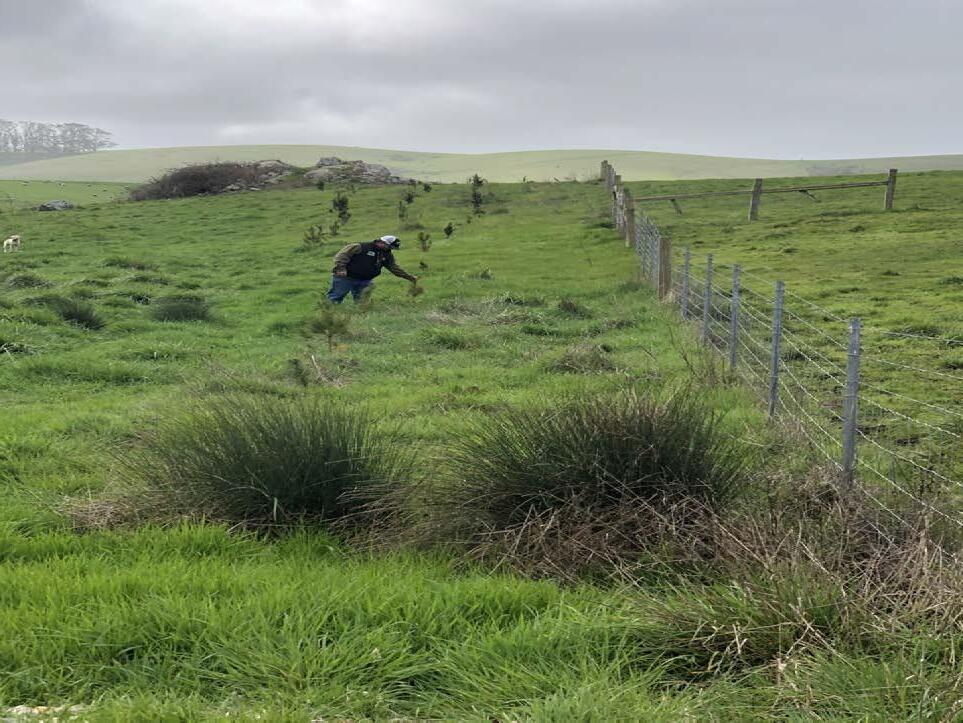
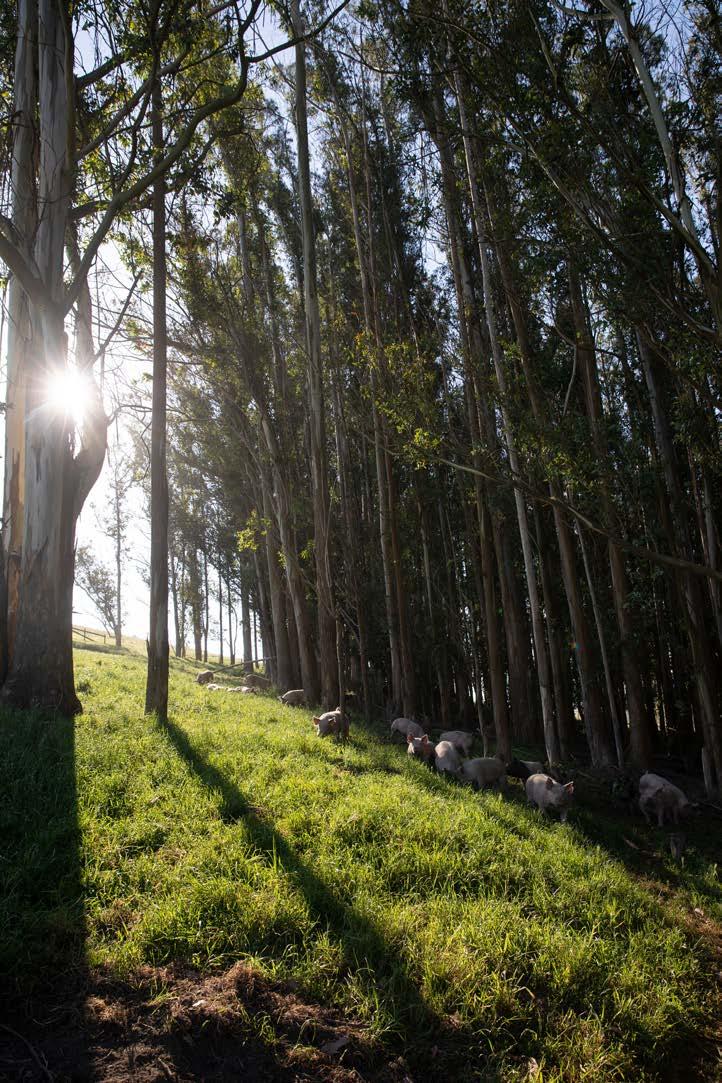
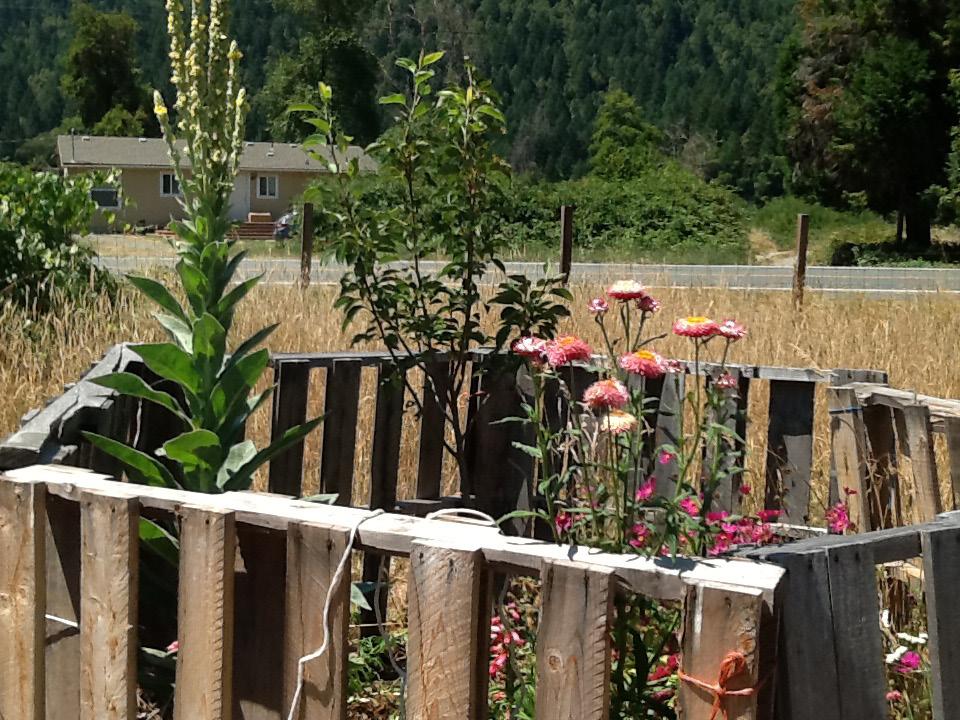
Silvopasture at Rhoby’s Ranch
BY RHOBY COOK
Ihave a pasture that fronts on the highway, so it’s visible to all of the local people who pass back and forth during the day. I know people watch what’s going on there, so I’m trying to demonstrate some regenerative practices without having to buttonhole them about it. The Hoopa Valley was maintained as an oak savannah for millennia by the Hupa people, but it was cleared and converted to cropland in the early 20th century. This particular pasture had been excessively mowed down to the bare ground for 30 years before I began managing it. The first step was to help the grass recover with managed grazing. I had read about how “stacking” grazing and trees improved productivity and soil quality, and I wanted to incorporate trees into my livestock operation. When our local Klamath Trinity Resource Conservation District offered $500 food production mini-grants to local producers, I spent my whole grant on fruit trees. I planted them in off-set rows about 30 feet apart. The fruit trees are standing in for the oaks for now.
The biggest challenge to combining baby trees and grazing sheep is, sheep prefer fruit tree bark and leaves to anything else available. I protect the trees with free pallets from wherever I can glean them, placed in triangles around each apple, pear, or plum tree. I can still run the electro-mesh between the trees to control where the sheep graze, and they are unable to reach the tree trunks. (Once grown enough that branches hang outside the pallets, the trees should be able to withstand some browsing.) One way I know people observe the field as they drive by is that someone asked my husband, “what kind of animals is she keeping inside those pallets?”
When I read about a Fibershed producer creating fenced off “refugia” for native plants in her pastures, it sparked the idea of adding pollinator plants. I have begun expanding the triangles to six-pallet hexagons with the young trees in the centers. I mulched each area inside the hexagon with a heavy layer of cardboard and barn litter and planted herbs and flowers. I have a few natives, such as mullein and yerba buena, but otherwise, I’ve just added whatever seeds and plants I had on hand, some annuals and some perennials. Although the flowers aren’t very visible inside their enclosures, this past summer, bees were quite able to find the various poppies, snapdragons, strawflowers, lobelia, and monarda that bloomed inside the hexagon gardens. I am planning to shift to native and perennial pollinator plants over time.
One limiting factor of the pallet system is that it works with sheep, but if I want to graze the area with cattle or horses, I will need to use a portable electric fence to protect the trees because large animals will reach over or rub-down the pallets. I think with the hexagon configuration, small goats would not be able to reach in even if they stood up on their hind legs against the pallets, but I haven’t tested it!
As the trees mature, they will provide summer shade and fall mulch. When they begin bearing, I will have plenty of fruit to share with community members. Windfalls are a big part of the sheep’s diet, as well as feeding foxes, skunks, and birds. What doesn’t get eaten above ground feeds the soil creatures. I keep thinking about what else could be added into the mix over time. Although the trees would make it challenging to revert to tractored row crops, I haven’t given up on vegetables! The sheep are spooked by the cars and avoid grazing in the pasture area very close to the highway. The standing dry grass there becomes a fire hazard. This year I am spreading cardboard and barn litter along the fence line to demonstrate occultation. I will plant winter squash, dry beans, corn, and perhaps zinnias to provide more food for animals, people, pollinators, and earthworms. Hopefully, now a few observers about how to grow a garden without any tillage.
Above, Loren Poncia inspects young fir trees at Stemple Creek Ranch
(Photo by Lynette Niebrugge); below, Silvopasture in the Eucalyptus grove at Stemple Creek Ranch (Photo by Paige Green)
The silvopasture at Rhoby’s Ranch incorporates fruit trees accompanied by native and pollinator plants uniquely protected by a pallet enclosure. (Photo by Rhoby Cook)
We need you!
An invitation to join the Northern California Fibershed Cooperative and the Fibershed Marketplace
Be part of the mutually thriving community of artisans, producers, processors, distributors, the general public, investors, and more.
As a member, you have a stake in fostering the collaborative efforts that strengthen the regenerative systems involved in producing regional fibers and goods:
• To drive and support expansion into new markets for farmers and independent artisans
• To make it easier for people to find and buy regionally grown, domestically produced goods that benefit our land, economies, and climate
• To support our efforts to provide training, workshops, agritourism, retreats, and other events that support right livelihood for farmers, ranchers, and artisans
• To support the ongoing operation of the online Fibershed Marketplace at fibershedmarketplace.com
Our mission and vision are to provide people with a consistently - always available - place to buy regeneratively raised goods. And to provide an online sales platform that members don’t have to pay for, maintain or handle accounting on their own.
Did you know:
• Membership as a Fibershed Producer does not equal membership in the Northern California Fibershed Cooperative or vice versa
• There is a one-time membership fee of $100 to join as an Individual Producer, Fibershed Producer-Dual Membership, or Individual Artisan
• By joining the Northern California Fibershed Cooperative, you are supporting fellow artisans and farmers
• Fibershed marketplace sales are steadily growing (see chart)
• To date, we have sold more than 680 items through the Fibershed Marketplace with more than $34K in revenue
• There are more than 320 active listings on the marketplace
• As a member, you are invited to attend our Annual All-Member meeting
• With social media and the internet, we are able to reach a wider audience of supporters and customers. We have followers and Fibershed supporters from around the world and customers from all over the United States.
• Fibershed Marketplace goals and objectives are to:
▶ To increase farmer and artisan labor, at least a little bit
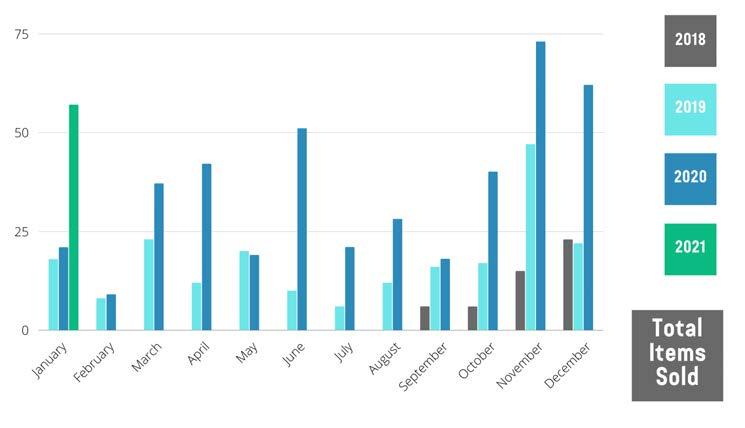
▶ To fully cover the online Marketplace costs with the 25% commission and no additional annual fees
▶ Only those who sell goods pay and participation essentially remains free and open to all
Will you join us?
Be as active as you want. Participation is not required but is appreciated. Join a board committee, add products to the marketplace, and/or encourage your friends to join! Together we can make a difference!
Meet the makers and preview our marketing plans for 2021 during the Fibershed Producer Meet-Up on April 30, 2021. We would love to answer any questions you might have. Please email questions to norcalfibershedcoop@ gmail.com
“Why Join Us” YouTube Video: https://youtu.be/-lTNTgHth3w
For more information about joining the Northern California Fibershed Cooperative, please visit: norcalfibershedcoop.com
Follow us on Instagram: @FibershedMarketplace and @NorcalFibershedCoop
Like us on Facebook: Fibershed Marketplace Shop at FibershedMarketplace.com
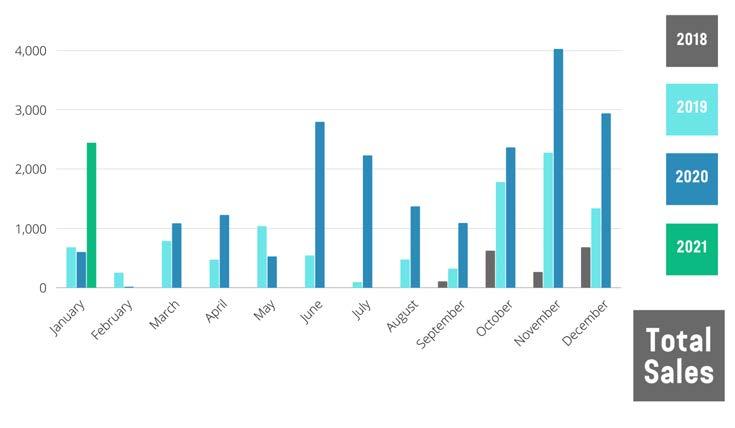
Producer Classifieds

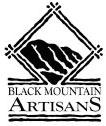
Black Mountain Artisans Bo-Rage Yarns
BMA is a retail collective of local fiber artists on Main Street in Point Reyes Station, a local equivalent of Fair Trade. Keeping our money within our community.
We offer one-of-a-kind accessories and garments that are hand spun, hand knit, hand woven and hand dyed from local wool and alpaca by local crafts people.
Until spring 2021, visit by appointment BMA@sonic.net

Wovens by Eleri Design
Certified Climate Beneficial™
Fibershed Scarf
Botanically dyed with walnut and indigo regionally sourced from Sweet Roots Farm. Hand woven with lace weight Rambouillet wool regionally sourced from Lani’s Lana.
eleridesign.com
eleridesigns@gmail.com
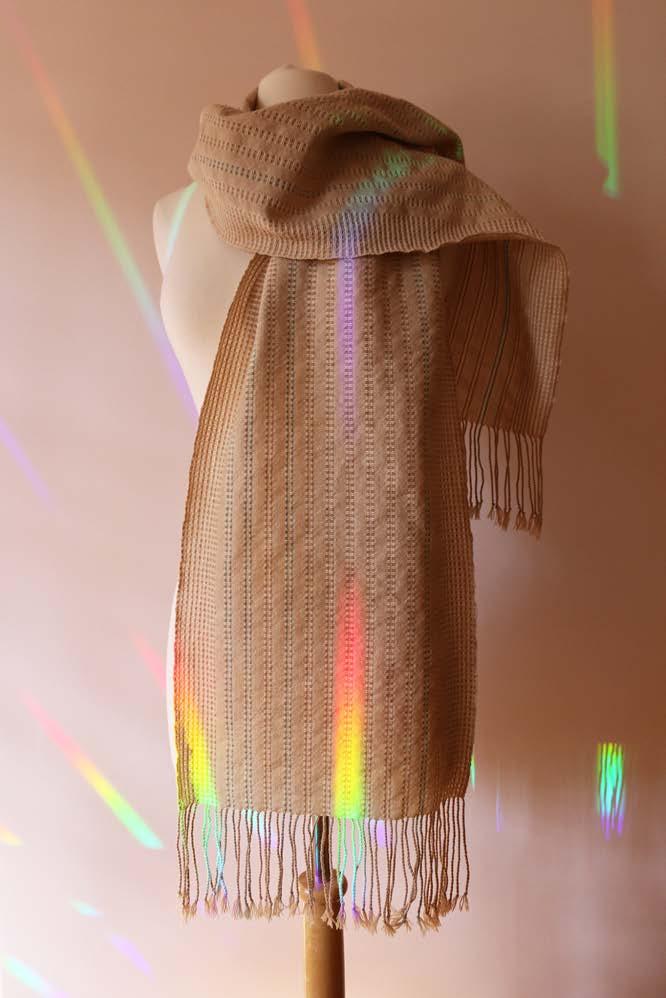

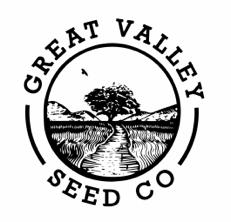
Great Valley Seed is strategically located in central California, targeting native seed specific to this region. We are looking to connect with restoration professionals, land managers, and pollinator habitat advocates to better understand native seed market demands.
To date, we have collected over 70 unique species traceable to specific ecotypes, increasing seed quantities on a number of them. We currently have ample supplies of milkweed, creeping wild rye, yarrow, gumplant seed, along with a plethora of smaller quantity items in inventory. We recently posted an availability list on our company website.
GVS is vertically integrated and well-positioned to offer custom grow outs with the ability to scale up production to meet future demand. We also offer custom transplant production and restoration services. We also offer a unique source of native fiber from bio-mass produced from our regenerative production blocks. This includes floss, stalks, and straw from our native material with bulk quantities available of milkweed, yarrow, and creeping wild rye production.
We are currently dialing in our production plans for next season and welcome your input to help us identify key species of importance to you and your organization. This feedback will allow us to adjust future production to effectively meet local restoration demand.
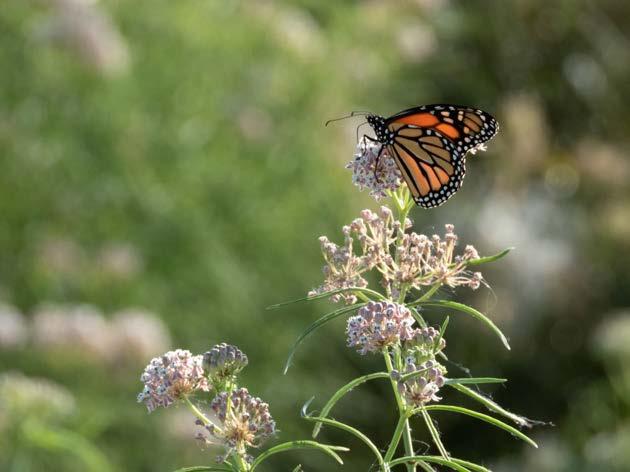
Looking forward to future endeavors. Contact us for more information.
Great Valley Seed Company 11609 Hereford Road Los Banos, CA 93635 (209) 827-3000 | doug@bfarm.com | www.habitat.farm
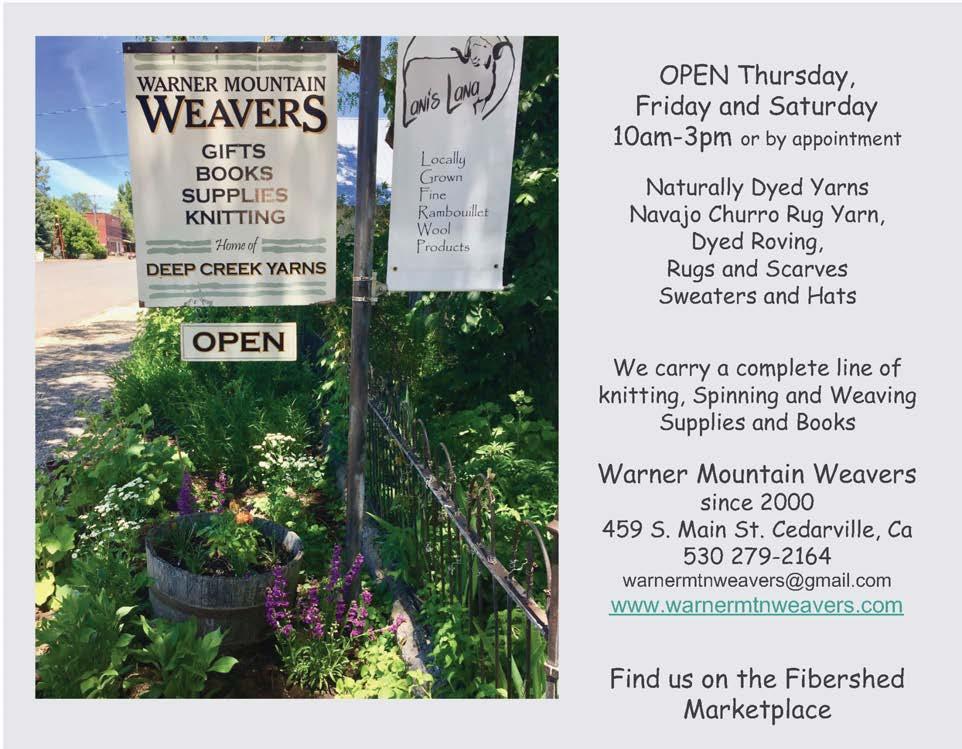
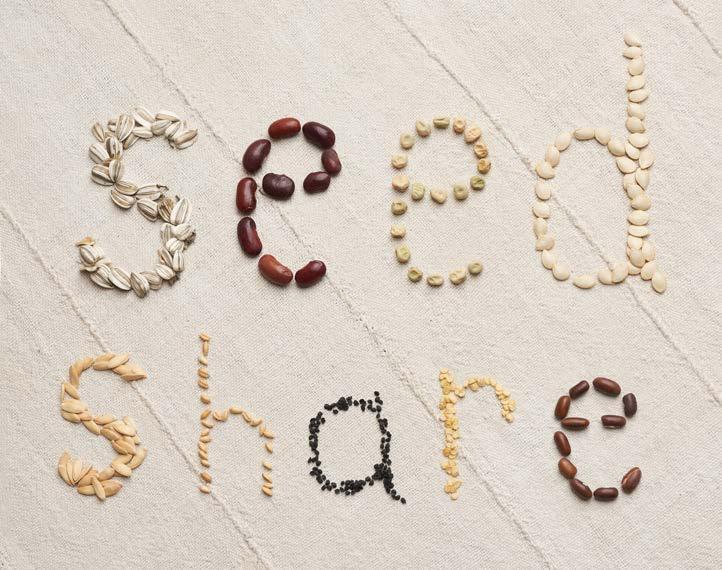
Introducing the Housework Seed Share free and open to anyone!
Saving and sowing seeds is an act of radical reciprocity between humans and the plants who sustain us. By stewarding seeds, we choose to become part of the cyclical life of plants, while nourishing our future generations. Seeking seed contributors of all kinds (food, fiber, dye) Learn more at www.housework.store/seedshare

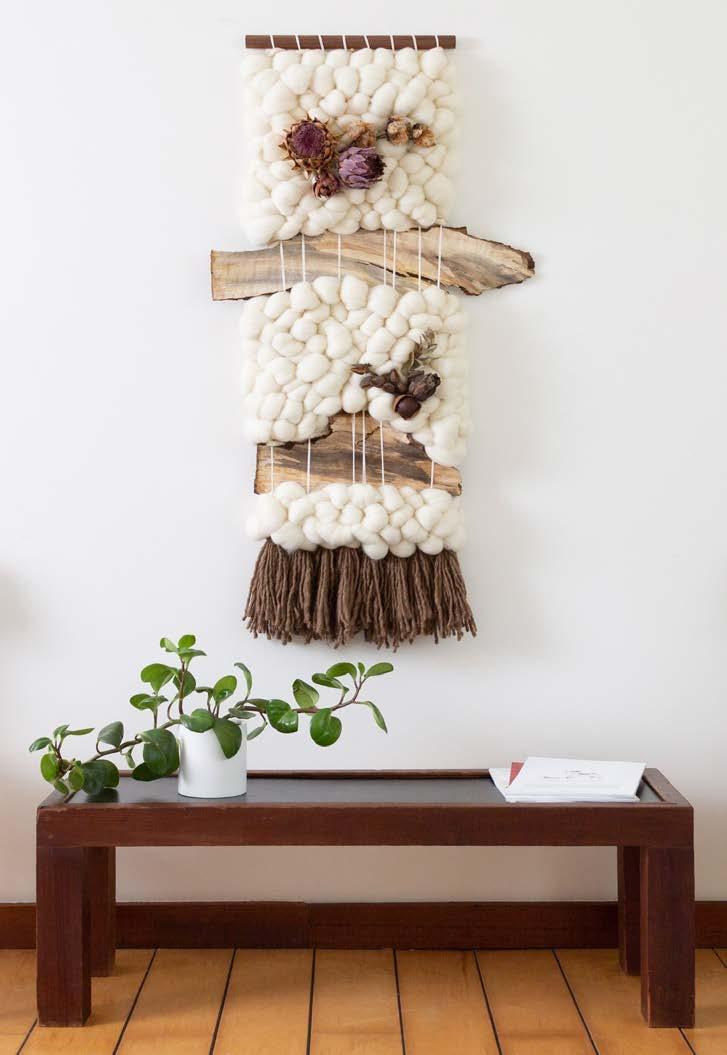
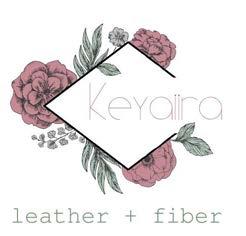
Combining modern & unique designs with unexpected plant-based materials is one of my favorite things. This nostalgic Fibershed Certified handwoven textile (Twiggy) will be a conversation piece in any space with its conscientiously sourced elements from, but not limited to, Lani’s Lana, Black Rock Ranch & Sally Fox.
Handwoven in Sonoma County by Keyaira Terry, owner & designer of Keyaiira | leather + fiber. Available at www.keyaiira.com
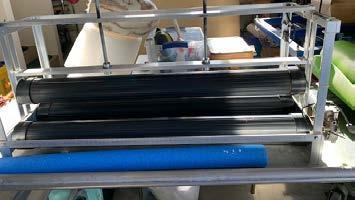
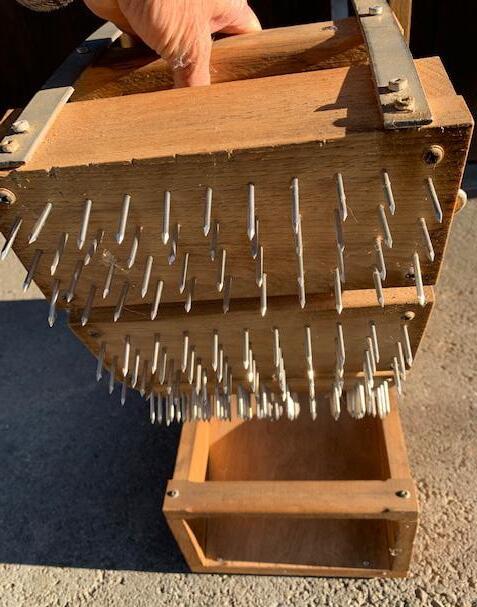
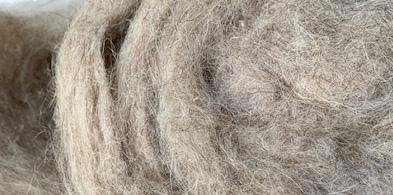

Looking for natural dye partnerships
Danu Organic is looking for natural dye partnerships! We’d love somebody to dye small batches of our clothing with a traditional indigo process. Also, we’re seeking to purchase madder root, gall nuts and logwood in the raw form. Everything must be organic, but not certified is totally fine.
Contact us at support@danuorganic.com.
West County Fiber Arts Felting Equipment for Sale
Belfast Wet Felting Machine • Wool Picker FeltLoom Lexi • Pedro’s Rollers
For full details and more photos of the equipment, visit my website: westcountyfiberarts.com/equipment-for-sale or contact Heidi Harris at 1sisuheidi@gmail.com
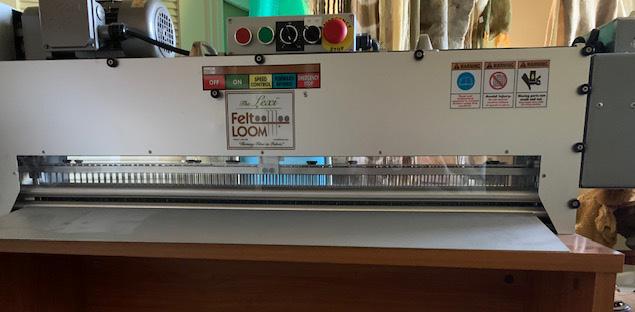
Clean and Carded Wool For Sale
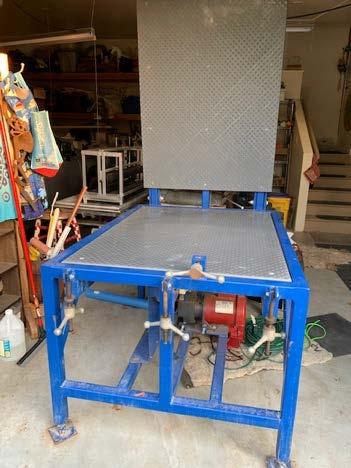
A mixture of local wool: churro, southdown, romney, merino Batts from the mill available in 1-lb. plastic bags at $3.00 oz./$48.00 lb.
Contact Heidi Harris at 1sisuheidi@gmail.com
More photos at westcountyfiberarts.com/equipment-for-sale
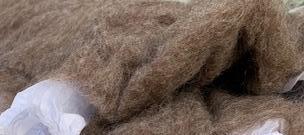

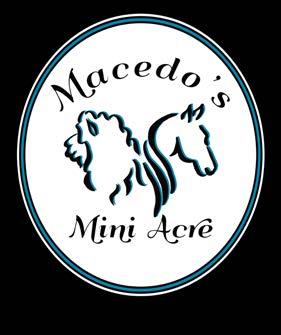
Alpaca Fleeces, Rovings and Yarn
Macedo’s Mini Acre, an alpaca and llama ranch located in Turlock, California. We feature a variety of colors in our herd of Suri and Huacaya alpacas. Fleeces, rovings and yarn available, as well as dryer balls, all created from our herd’s fiber. www.macedosminiacres.com
Meridian Jacobs
At Meridian Jacobs we raise Jacob sheep and support all fiber endeavors by selling fiber, yarn, and spinning and weaving equipment. We teach classes (now virtual) in fiber crafts and livestock management and offer Farm Club memberships. We hope to recommence field trips, farm tours, and on-site classes later in the year. Robin weaves and sells handwoven pieces through the Fibershed Marketplace and her own website, meridianjacobs.com
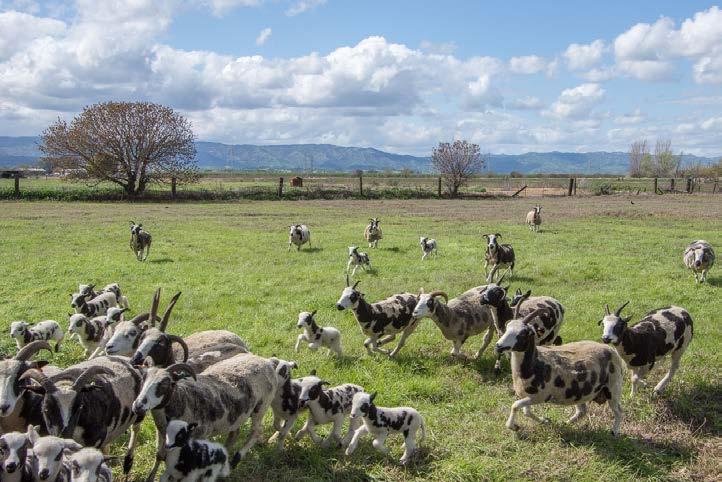
Lani’s Lana Fine Rambouillet Wool
Lani’s Lana (Spanish for Wool) offers a product that is produced right here in Northern California. We have an amazing fine wool that is available as yarn, combed top and fabric.
Check out my new wholesale website available to commercial artisans lanislanawholesale.com. Especially if you want fabric or yarn to make something for the Fibershed Marketplace, I would love to work with you!!
Email lanislana22@gmail.com or check out the website lanislana.com
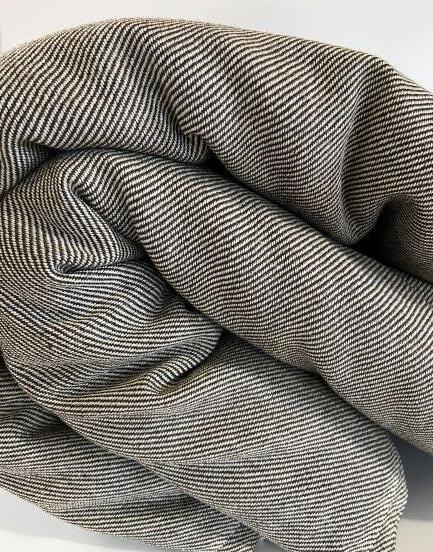
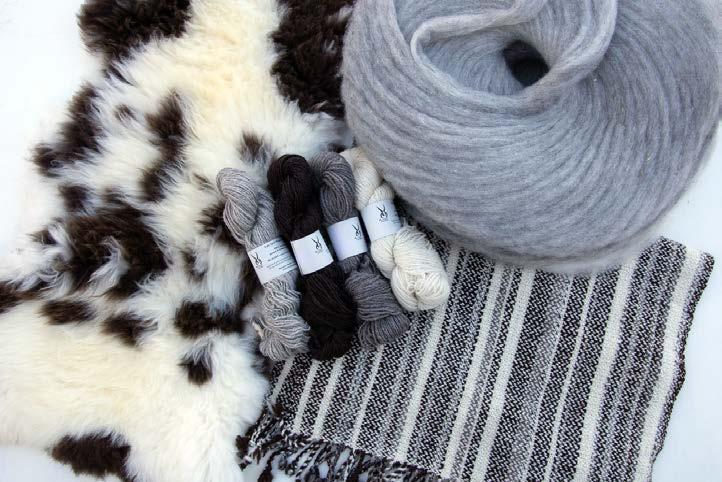
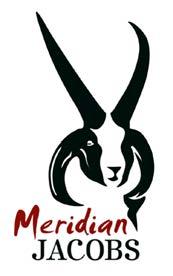
The ewes will start lambing at the end of February and into March. We sell lambs and sometimes ewes with lambs to people who want to raise their own breeding flock or maintain a flock for their own fiber needs. There is information about all of this on the website and the best way to find out about new products, lambs, etc is by signing up for our newsletter.

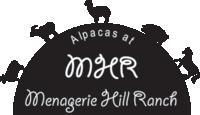
Alpaca Manure
Fresh or lightly composted alpaca manure is mild enough to top dress your plants, but nutritious enough to enrich your soil. Bring your truck, we’ll load it for you. By the pickup load (4-5 ¼ yard buckets) or trailer load - $10 per load/yard.
Alpaca Rentals
For Weddings, Special Events, Photo Shoots. Make your occasion special and fun! Call or e-mail for pricing.
Alpaca Products
Alpaca fleece, roving and yarn for your next project. Natural colors: white, light fawn, brown, silver grey, rose grey and black. Visit our farm store for best selection. Appointments required. Menagerie Hill Ranch, Vacaville, CA Deb 707.290.7915 deb@menageriehillranch.com
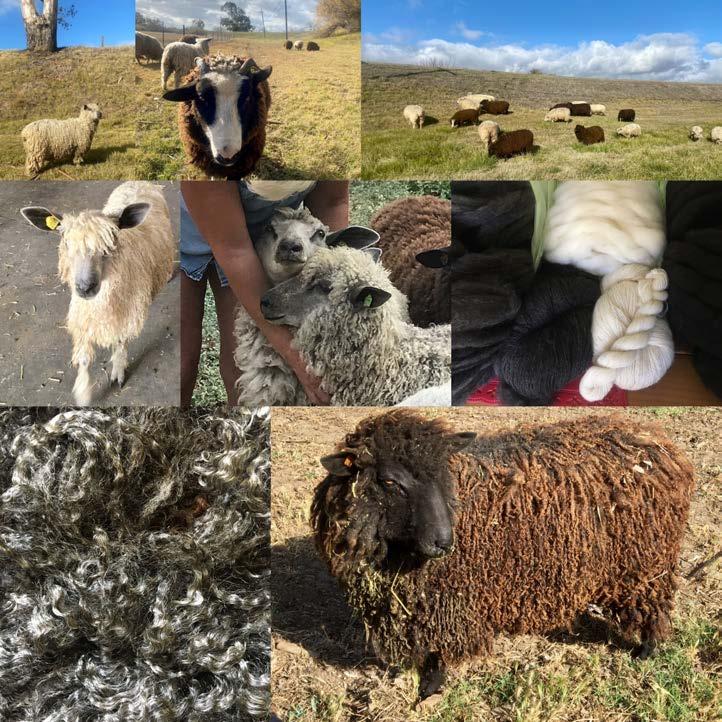
Fox Farms Raw Fleece, Yarn & Roving
Fox Farms has raw fleece for sale from our registered Wensleydales! Also have mixed wool breeds with light and dark wool (Merino/Jacob, Wensleydale/Finn/Friesian). Yarn and roving are samples of last year’s fiber after processing. Lambing in April!
Find me on Instagram: @foxfarms17924
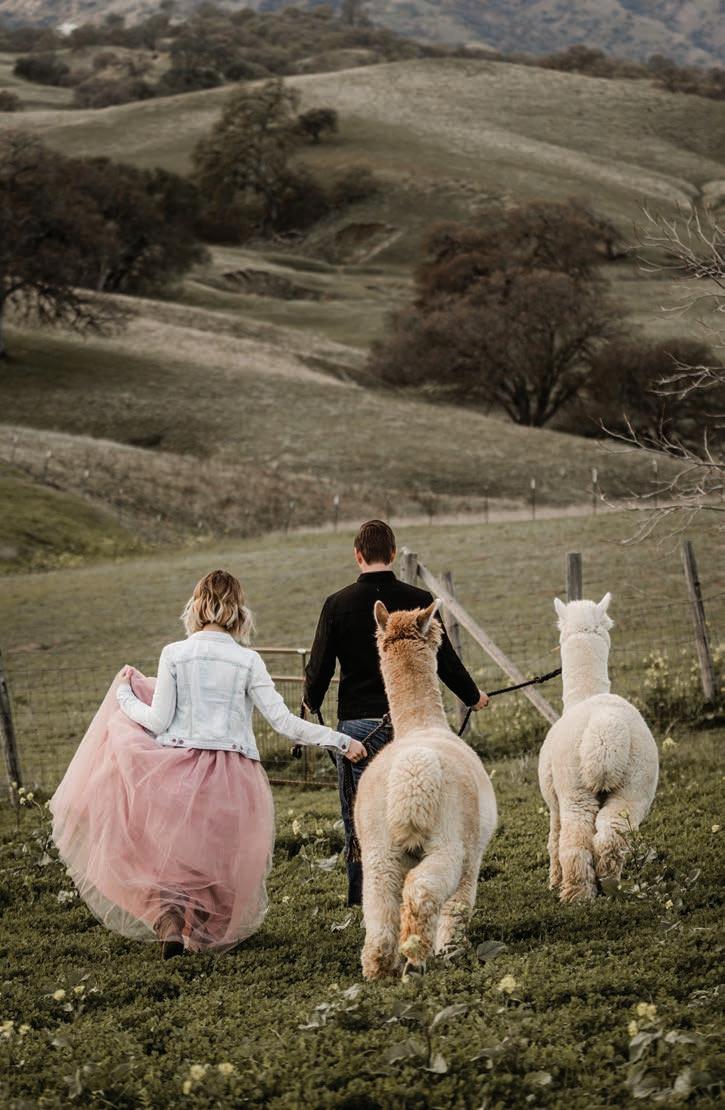
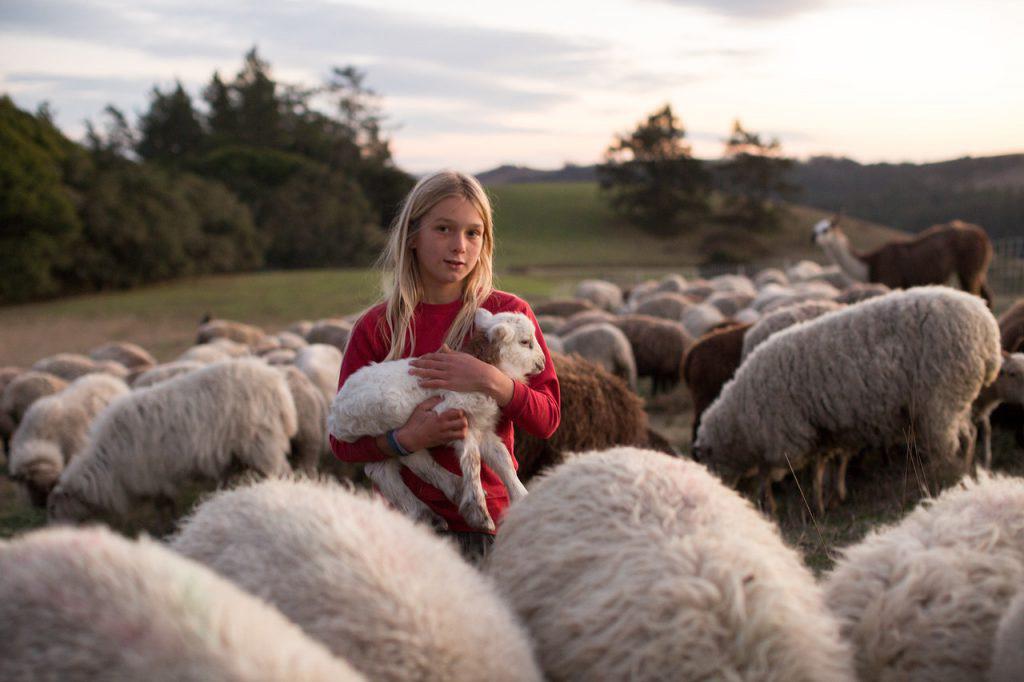
Bodega Pastures
Ewe lambs from our flock to yours $150. Variety of breeds including Corriedale and Navajo. Growing well with their moms. Available this spring and summer. Our wool products; beautiful new batting $20/lb.; Roving by the pound, yarn $15/4oz skein and raw fleeces $6/lb.
Contact Hazel Flett by phone (707) 327-6816 or email mroskool@icloud.com
Three Bags Full Wool
Taking orders now! Spring shearing is just around the corner. Raw fleeces, processed wool roving, wool batting. Purebred Scottish Blackface fleeces (easy to wash; no carding required; excellent for weaving) Scottie cross fleeces (roving and batting), Wensleydale cross fleeces white/colored.
Contact: threebagsfullwool@yahoo.com
Summer Solace Tallow x Northern California Fibershed Coop Marketplace
Visit the Summer Solace Tallow x Fibershed Cooperative booth every other Sunday at the Temescal Farmers Market in Oakland. There you can peruse our curated selection of Fibershed products including locally spun yarn, Climate Beneficial™ felted home goods, handwoven shawls, blankets, luxurious sheepskins, as well as Summer Solace tallow-based body care, soaps, and candles.
Find us every other Sunday from 9:00 a.m. to 1:00 p.m. at:
Temescal Farmers Market
5300 Claremont Avenue | Oakland, CA 94618
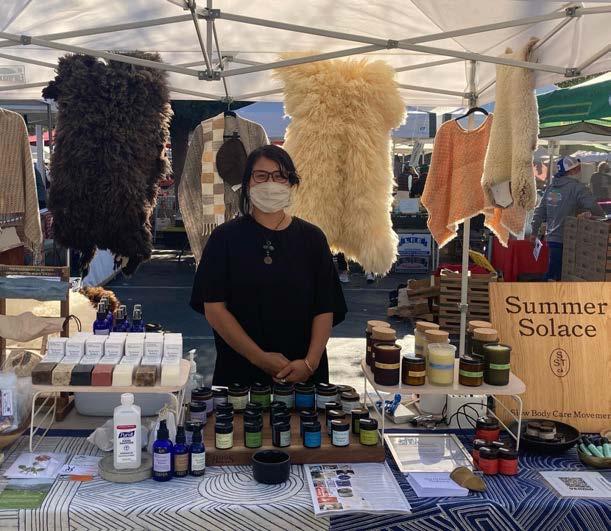
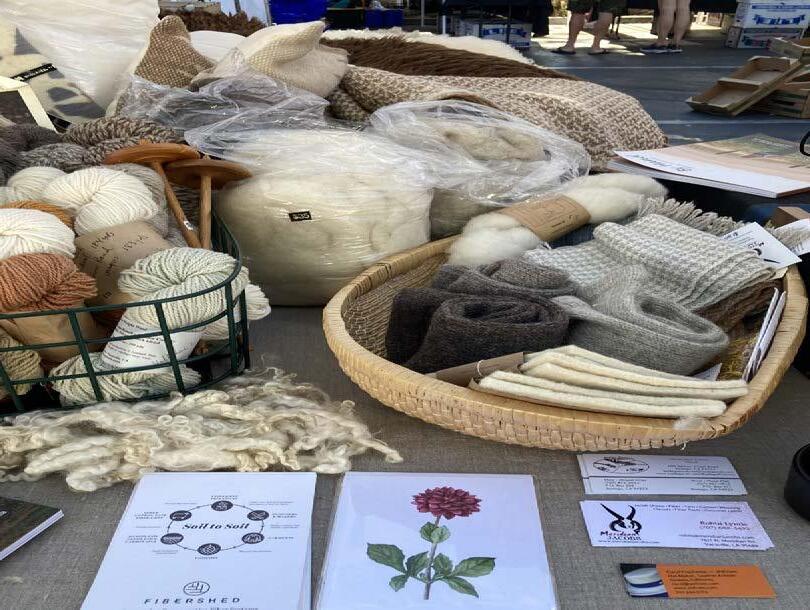
Shop online at www.summersolacetallow.com @summersolacetallow
Email: megan@summersolacetallow.com for any inquires
This sixth volume of the Fibershed Producer Newsletter is designed to be a space to re-acquaint and connect, as well as refresh ourselves on the who and what of our projects and collective efforts.
We look forward to hearing from you about what kinds of information sharing, column ideas, poems, art, doodles, updates on your family and business, and notes from the field that you’d like to offer for the next publication. Newsletters come out twice yearly, and our next edition will be sent in September, 2021.
Ongoing Public Notices: Do you have an internship, a residency, an ongoing course or service that you offer? We will again include a Producer Classified Section in our next newsletter.
Classified ads, as well as your thoughts and visions, should be emailed to marisol@fibershed.org Feel free to submit both your ideas and your classified ads between now and July 23, 2021.
Fibershed Affiliate Voices
Swatch Books as a Source of Community Mapping
Many of our Fibershed Affiliate peer communities have created fiber sample books, similar to the Bioregional Book of Wool that we produced for the Northern California Fibershed. It is exciting to see how different regions approach their sourcebook process and products. While the NY Textile Lab, a member of our Fibershed Affiliate community, developed their Regional Sourcebook specifically to serve as a tool for small and mid-scale designers to identify yarns for product development, most communities have found that these tactile sample books function as interactive educational tools for their fibershed. Most recently, the Three Rivers Fibershed in Minnesota and the Connecticut Fibershed created sourcebooks, surveying their regions to connect with fiber producers, collaborating with artists and craftspeople to create material swatches and diagrams, and sharing the results in community.
We thought our Northern California Producers might appreciate these kindred approaches to understanding the rhythms and resources of regional fiber and dye systems.
In Minnesota, the Three Rivers Fibershed created a material sourcebook as a means to “provide to the producers within TRF niche market consultation and group education opportunities to assist with individual branding, marketing, and value-added product creation. Producers will have a direct say through the use of a survey in helping determine
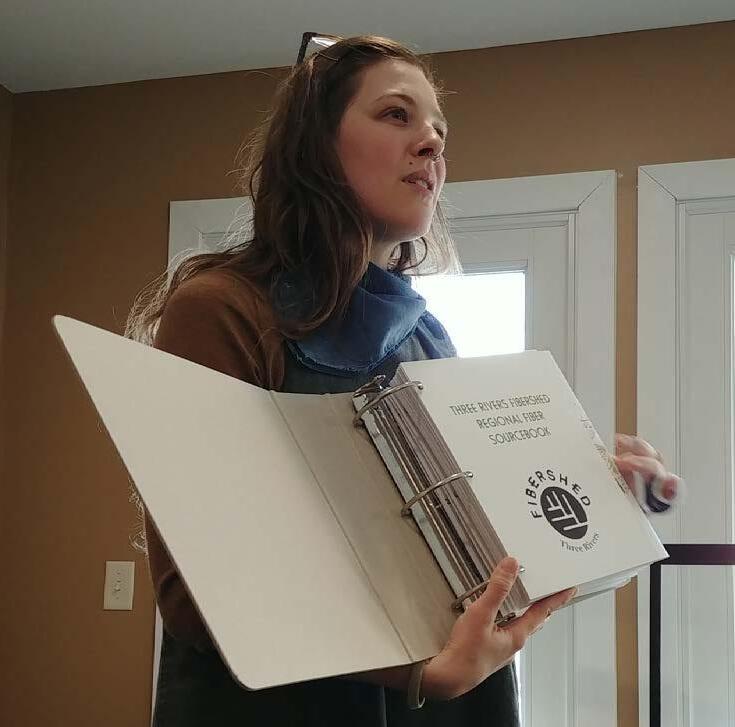
Maddy Bartsch, co-founder and organizer of the Three Rivers Fibershed in Minnesota, displayed the Regional Fiber Sourcebook at a community event (pre-COVID-19).

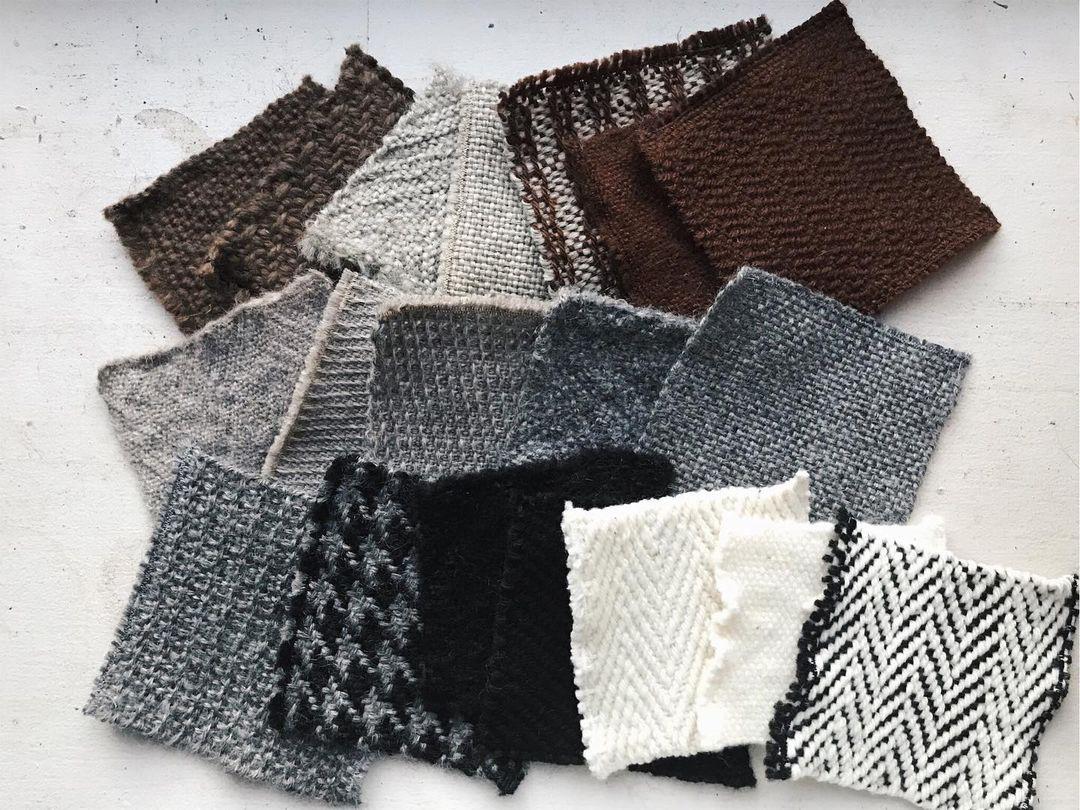
what areas of education they will receive.” Organizer Maddy Bartsch shared that “Producers included in the sourcebook have successfully completed the “fiber portfolio” program with Kyle Huneke of Riverland Community College. TRF Producers included in the sourcebook have completed their farm narrative and accompanying information for the sourcebook.
The sourcebook includes woven and knit samples, illustrations including a map of strategic geography, local fiber timeline, fiber to yarn/fabric illustration, illustrations of types of animals for the definition page at the beginning. Learn more and explore the sourcebook at: threeriversfibershed.com/regional-fibersourcebook. Connect with their community through Instagram @ threeriversfibershed
The Connecticut Fibershed is working on their first inventory and analysis of local fiber and yarn quality and quantity, which will be documented in a sourcebook and shared at several events in the region, including fiber festivals. The organizers shared progress photos and noted: “The first batch of yarns for the swatch book has come in and through a partnership with [TILL: bioFASHIONtech LAB] they’re off to a materials scientist at Stony Brook University, for analysis, helping better to understand the unique properties and opportunities of Connecticut wools. We’re excited to hear what they have to say.” Connect with their community through Instagram @ctfibershed
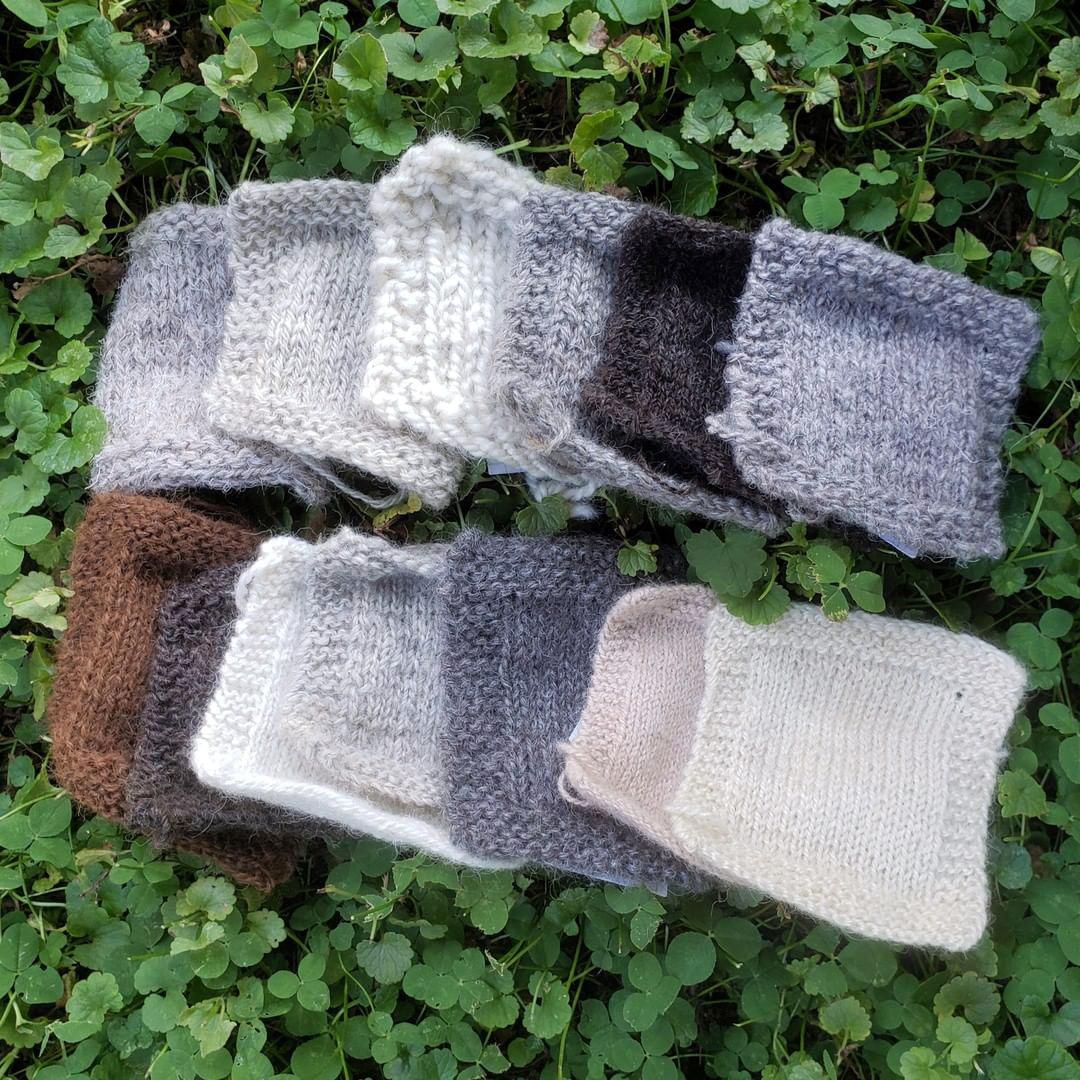
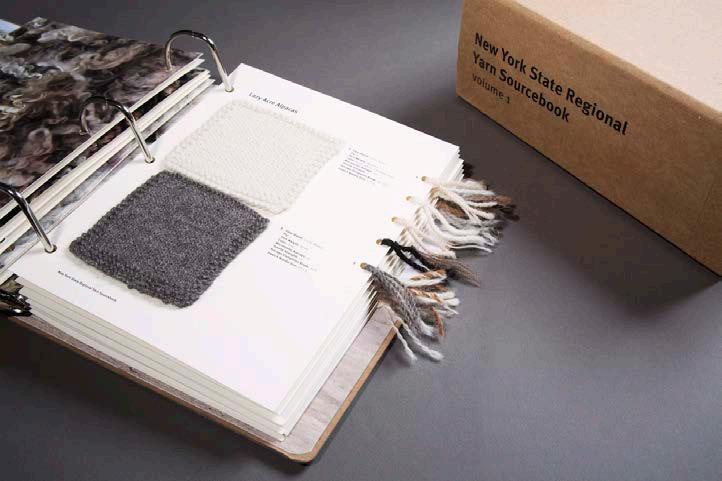
Bioregional fiber sourcebooks include swatches to provide tactile representation of local fiber systems, as shown above (clockwise from top left: Three Rivers Fibershed, CT Fibershed, and NY Textile Lab Fibershed Affiliate).
